September to December 2014
2014 December 12
Jeremy Tatum writes:
The current (Winter 2014) issue of BC Nature includes an article in which it is proposed to introduce large numbers of European butterflies (such as Peacock and Map butterflies) to Salt Spring Island. These are to be obtained from a commercial supplier in England, known as World Wide Butterflies. The proposed butterflies include Painted Ladies which have been “specially designed” and have been artificially reared for generations on Stinging Nettles, which are not their usual foodplant here. The author is applying for a permit from Parks Canada.
This site would welcome short comments. Some viewers might also want to send comments to BC Nature or perhaps also to Parks Canada.
The article is illustrated with photographs of three butterflies. One is our native Milbert’s Tortoiseshell. Another is the Peacock butterfly, well known in Britain. The third is labelled “Red Admiral”. Viewers of this site who have seen the article will recognize that this is not the Vanessa atalanta commonly known here and in Britain as the Red Admiral, and may wonder what the illustrated butterfly is. It is in fact Vanessa gonerilla, a New Zealand endemic, known there as the New Zealand Red Admiral.
2014 December 04
The introduced European Winter Moth Operophtera brumata is usually a rather featureless grey (like the November 10 photograph), although some specimens can be quite well patterned. I think the European one is the one most often (almost exclusively?) seen in Victoria. The native Bruce’s Winter Moth O. bruceata (which Bill Katz and Jeremy Tatum have found at Goldstream Park), is usually well patterned. Annie Pang sends a photo of a winter moth from her kitchen window in Victoria. Although it is well patterned, Jeremy Tatum and Jeremy Gatten believe that this is a European Winter Moth O. brumata.
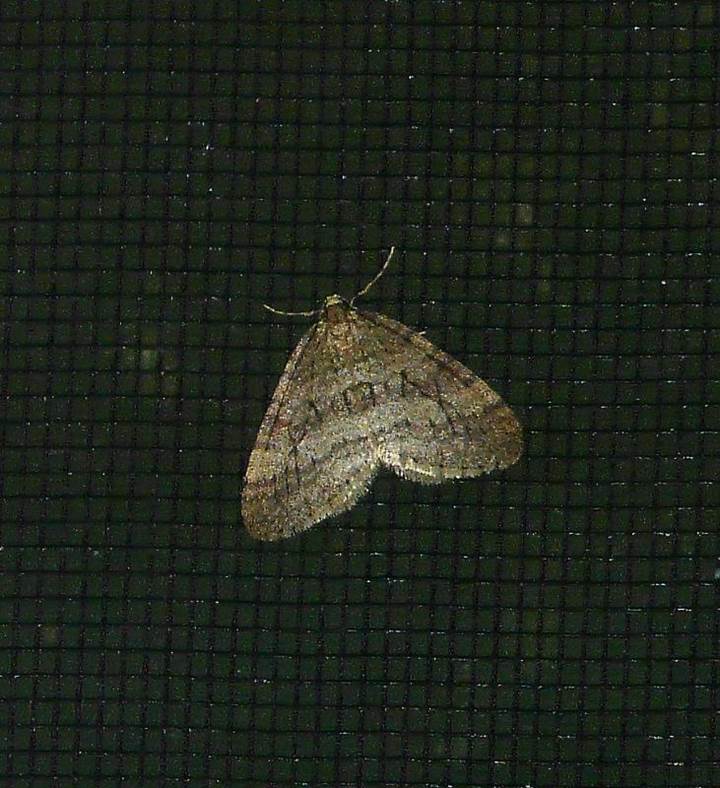
Winter Moth Operophtera brumata (Lep.: Geometridae) Annie Pang
2014 November 28
Winter Moths are abundant everywhere now. I have been seeing clouds of the flying males in my car’s headlamps at night. Here is a flightless female from my Saanich apartment on November 25. We have had some spectacular creatures on this site. This is perhaps one of the less spectacular ones. Jeremy Tatum
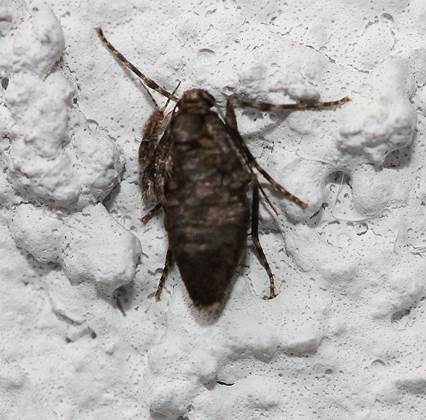
Winter Moth Operophtera brumata (Lep.: Geometridae)
Jeremy Tatum
2014 November22
No recent reports of interesting invertebrates, but Aziza Cooper writes:
Hi Jeremy, Mike Yip was kind enough to give me a copy of his and James Miskelly’s’ lovely new book: Vancouver Island Butterflies. He writes that he’s had some enthusiastic comments from Norbert Kondla, Cris Guppy and Dr. David James.
I’ll add my own comment: this book is a must for local butterfly chasers, and I’m already looking forward to chasing some of the more elusive species next year.
The book is available now in several Victoria bookstores: Munro’s, Bolen and Ivy’s, and Tanners in Sidney as well as at Victoria Camera Repair.
It would be nice if you could mention it on the InvertAlert. I’ll understand if you don’t feel it’s appropriate to post an ad for Mike’s book, but I would really like to support his efforts. The book is the only book on Vancouver Island butterflies. I’m sure your readers would be interested, and it would make a great Christmas gift.
Jeremy comments: I’ve already asked Santa to get me one for Christmas. I hope I’ve been good during most of the year.
2014 November 14
Aziza Cooper writes: While looking for the Cattle Egret in Vic West on November 10, I had two sightings of Cabbage White. The first was at the east end of the Johnson Street bridge, flying past ornamental trees at the Wharf Street and Johnson Street intersection. The second may have been a different individual. It was at the Cattle Egret location near the Bayview condo towers. It was on the green space between the condos and the railroad tracks, west of Tyee Road. These are the latest butterflies I’ve seen in Victoria.
2014 November 10
Winter Moth season has arrived. Jeremy Tatum photographed the first one he has seen this season at his Saanich apartment on November 10. They will probably be seen everywhere on a daily basis from now on during November and December.
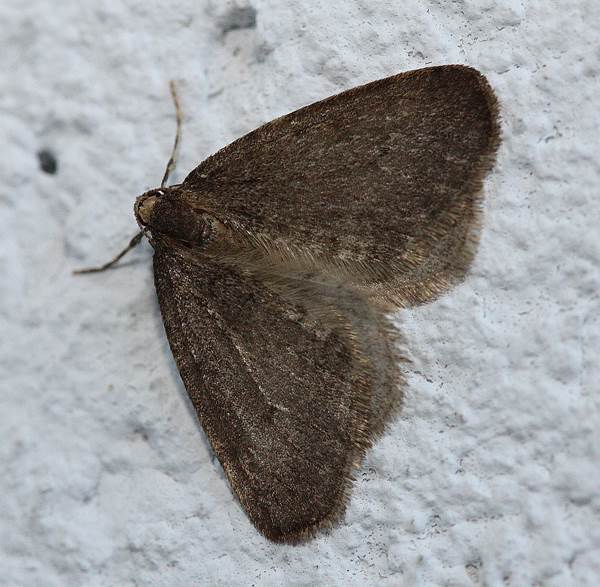
Winter Moth Operophtera brumata (Lep.: Geometridae) Jeremy Tatum
Gordon Hart writes: I saw the bug in the pictures below on November 5 at Viaduct Flats on the viewing platform. With the continuing warm weather, I saw a large Aeshna dragonfly – probably a Paddle-Tailed Darner A. palmata – on November 5 at Viaduct Flats, and again on November 6, at home during a sunny break. I guess they will continue until we have a cold spell.
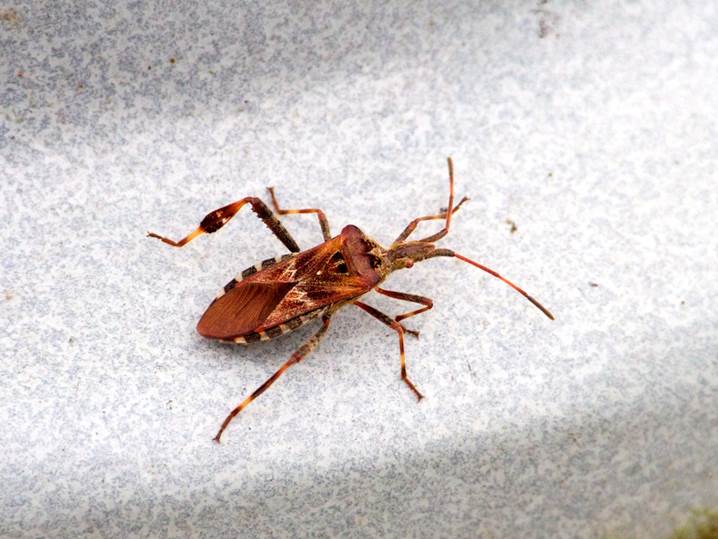
Western Conifer Seed Bug Leptoglossus occidentalis (Hem.: Coreidae) Gordon Hart
2014 November 6
Aziza Cooper sends a picture of Erannis vancouverensis on the glass of her back door at Brighton Avenue and Foul Bay. Very similar to Bill Katz’s November 2 photo – also on the glass of his back door! The more I look at these moths, the more I am convinced that there really is no such animal as Erannis vancouverensis, and the moth is in fact, like the Winter Moth, a European invader, namely the Mottled Umber Erannis defoliaria.
Jeremy Tatum
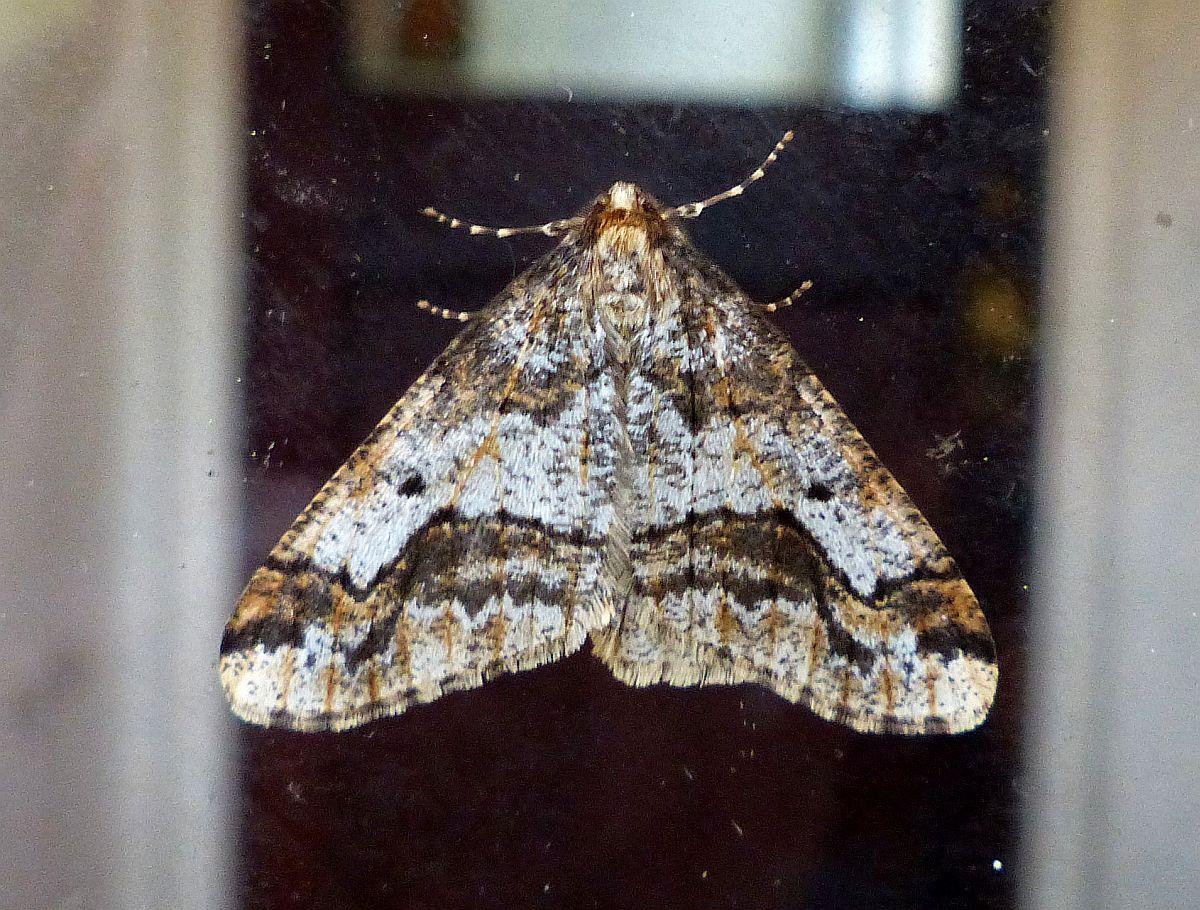
Erannis vancouverensis (Lep.: Geometridae) Aziza Cooper
We are by now well past summer, but it is still possible to find caterpillars. Jeremy Tatum found this one at Martindale Flats on November 1. Another European invader!
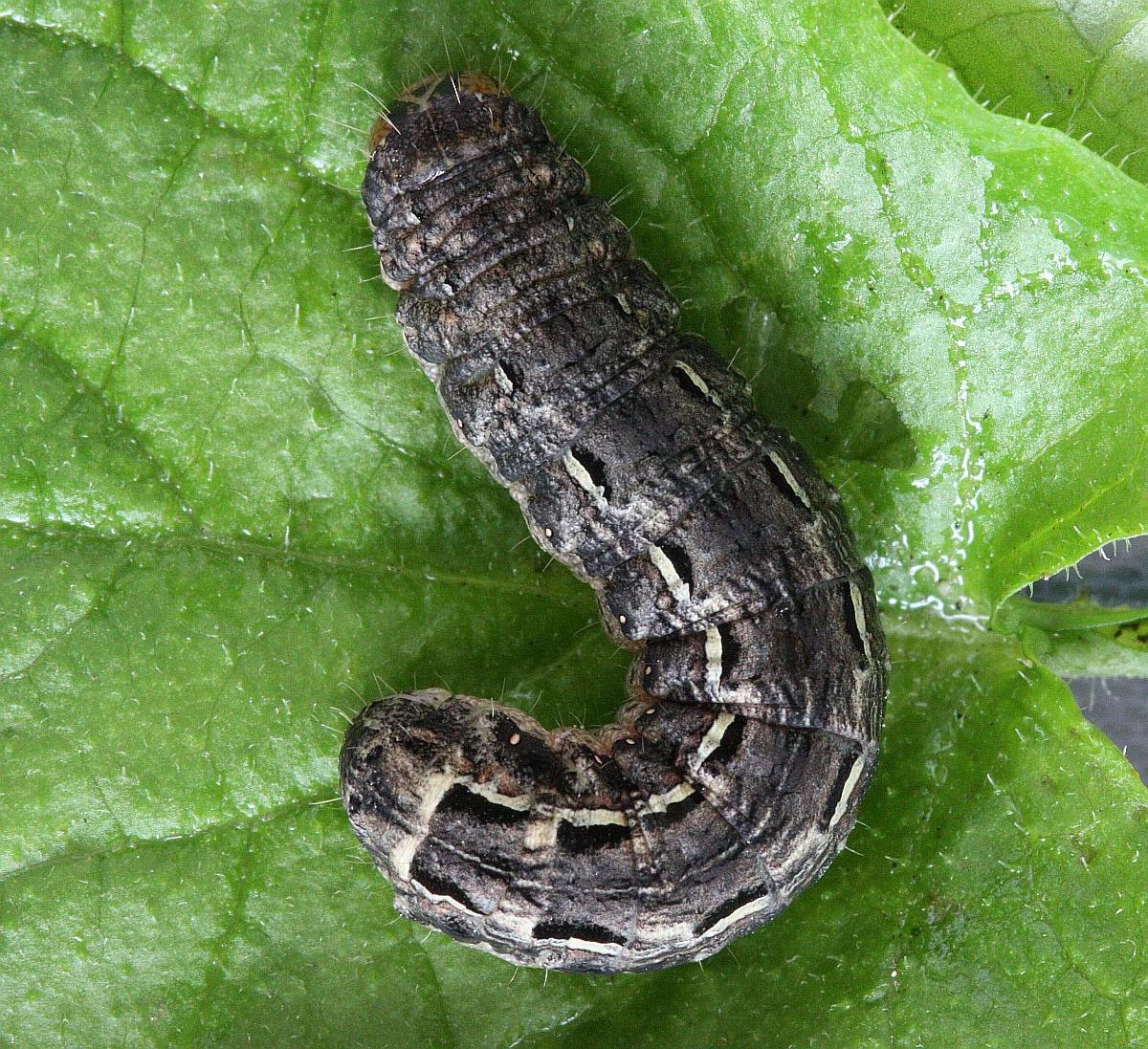
Large Yellow Underwing Noctua pronuba (Lep.:Noctuidae) Jeremy Tatum
2014 November 1
Mike Yip writes: My books [see October 22 Invert Alert for a notice about Mike’s book on V.I. butterflies] arrived early and I’m delivering down your way on Nov. 3. Munro’s, Bolen, and Tanners are all on board, and I have about a dozen orders from various individuals.
Bill Katz writes: An Erannis vancouverensis on our building front door, my first of the season, is greeting Hallowe’en visitors on Summit Hill.
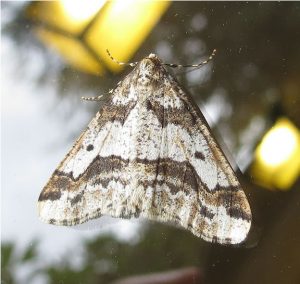
Erannis vancouverensis (Lep.:Geometridae) Bill Katz
Jeremy Tatum found the spider below at Swan Lake on October 29. Robb Bennett, who kindly identified it, writes: Your beast is one of BC’s half dozen or so mygalomorphs. A male of Antrodiaetus pacificus. One of my personal favourites!
In case anyone is wondering what a mygalomorph is, the Mygalomorphae are a suborder of spiders characterized by downward-pointing chelicerae, including funnelweb, trapdoor, and purseweb spiders. The Antrodiaetidae are trapdoor spiders. They are very appropriate animals to see at Hallowe’en.
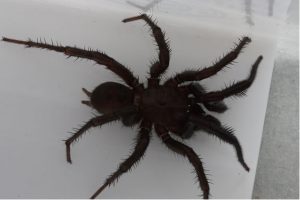
Antrodiaetus pacificus (Ara.: Antrodiaetidae) Jeremy Tatum
Jeremy continues: The two animals shown below, photographed in my Saanich apartment in the last few days, are members of the Order Thysanura (three-pronged bristletails), Family Lepismatidae (silverfish and firebrats). Both are firebrats. The first is the Common Firebrat Thermobia domestica. The second might possibly be a colour variety of the same animal, but I believe it is more likely a different species, namely the Grey Firebrat Ctenolepisma longicaudata. While interesting, they were uninvited guests in my apartment and were beginning to make themselves unwelcome. Who will rid me of this turbulent animal? (That’s a misquotation from Henry II.) The answer is Marlin Smyth, whom many of you will know, and who is an experienced professional. He came to rid me of them yesterday morning, and I haven’t seen any since.
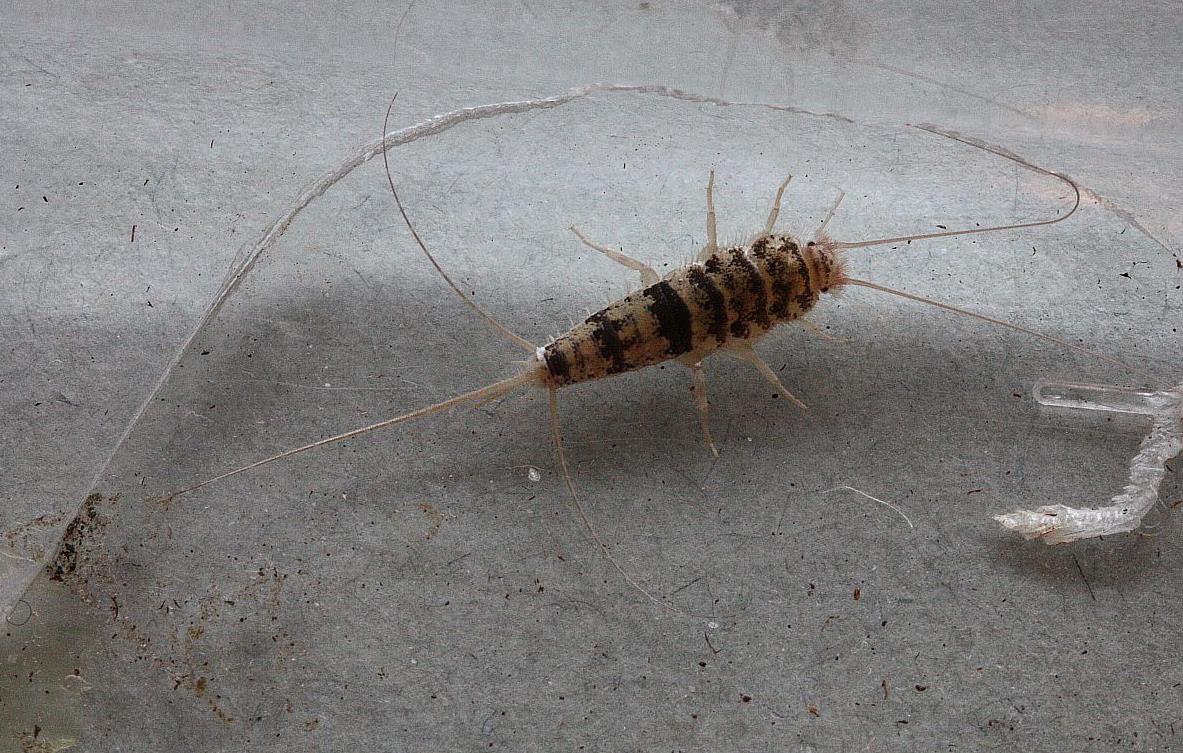
Common Firebrat Thermobia domestica (Thy.: Lepismatidae) Jeremy Tatum
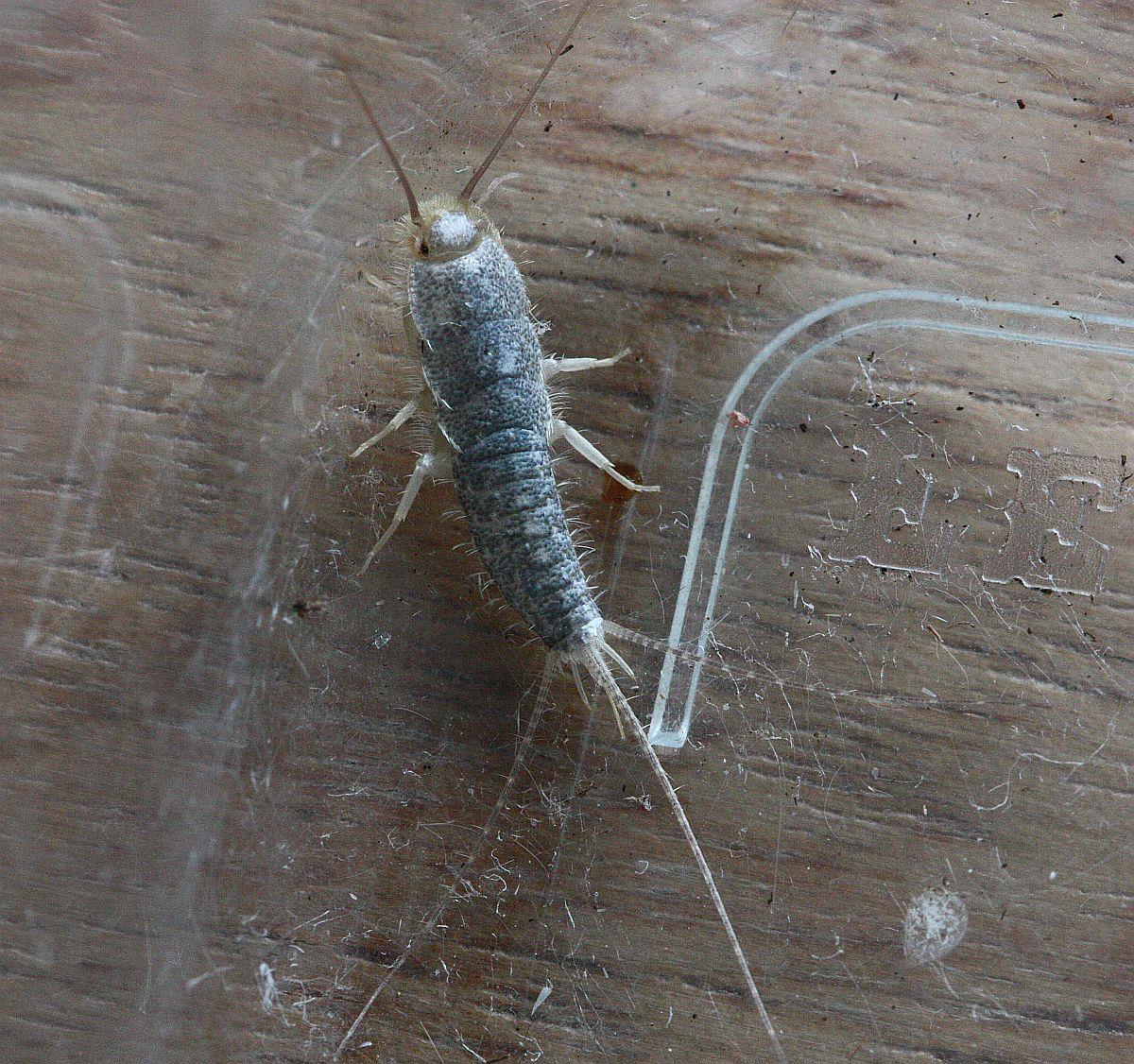
Grey Firebrat Ctenolepisma longicaudata (Thy.: Lepismatidae) Jeremy Tatum
Although the butterfly season is winding down, there are still lots of other terrestrial invertebrates to see, such as the slug below, Limax maximus, from the Martindale Valley, November 1. It is variously known as the Great Grey Slug or the Giant Garden Slug. These slugs mate by wrapping themselves around each other and writhing while suspended from a rope of slime.
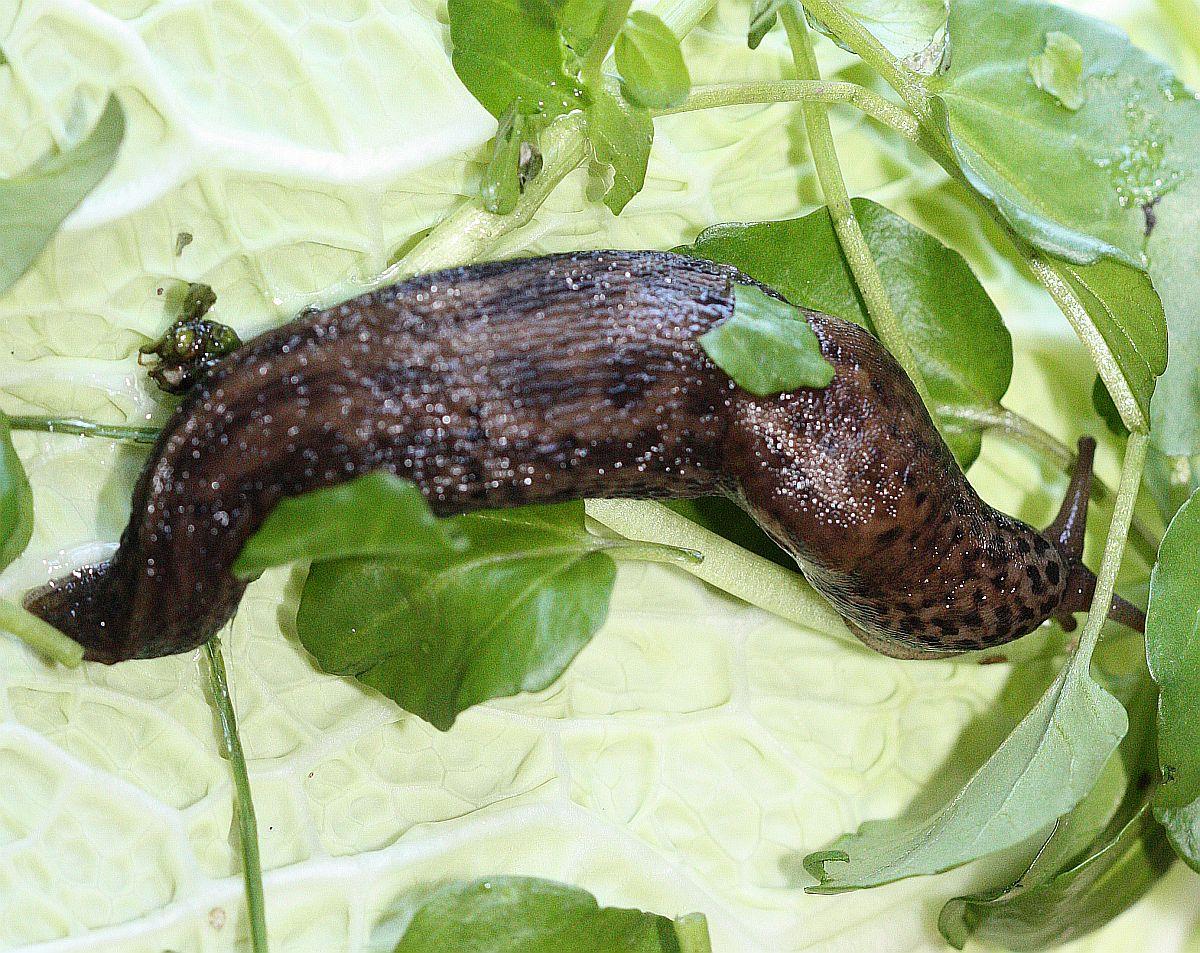
Limax maximus (Pul.: Limacidae) Jeremy Tatum
2014 October 28
Aziza Cooper writes: On October 21, a Cabbage White was at the Orange Sulphur location along Martindale Road, north across from the kiwi farm. This is one of the more likely places to find one to try and extend the butterfly season into November! Thanks to Claudia Copley for identifying a grasshopper that Aziza photographed in August. We’ll let viewers scroll down to September 5 to see what it was!
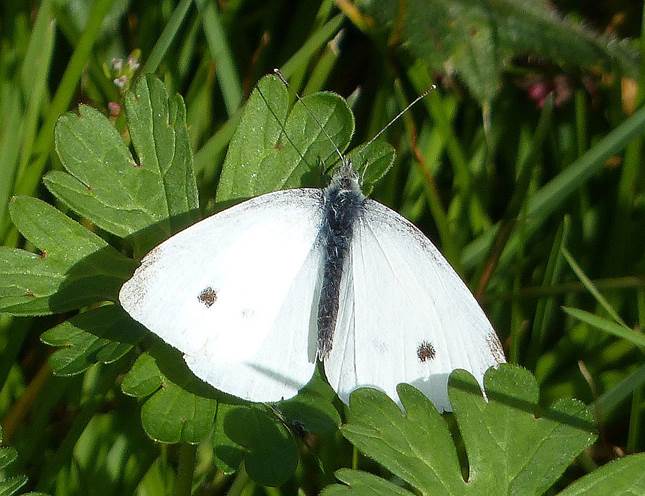
Cabbage White Pieris rapae (Lep.: Pieridae) Aziza Cooper
Jeremy Tatum sends a photograph of Cucullia montanae from Island View Beach, October 23. It wears a hood (Latin Cucullus) over its head.
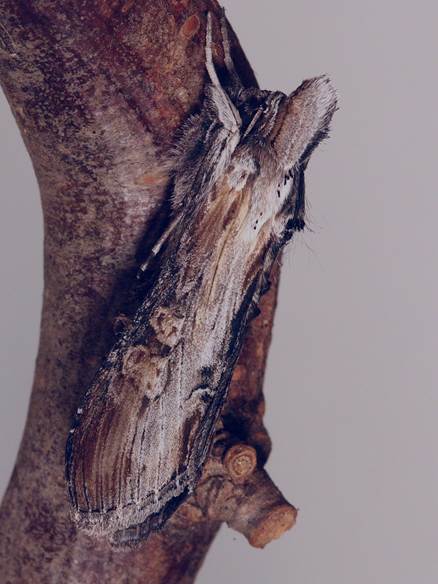
Cucullia montanae (Lep.: Noctuidae) Jeremy Tatum
Gordon Hart found a geometrid on October 9, but so far we have not been able to identify it. Suggestions welcome.
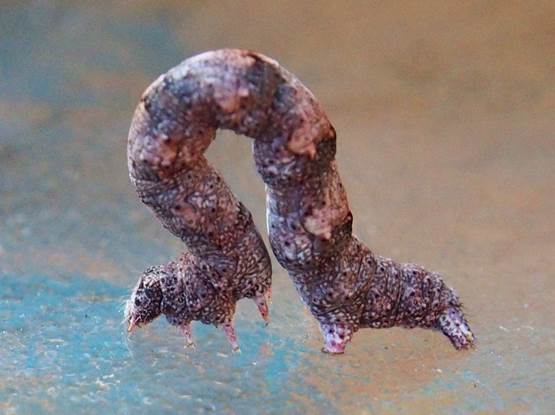
Unknown geometrid – Gordon Hart
Jeremy Tatum photographed a spider in his Saanich apartment building on October 25.
He writes: You can patiently explain to me all day that they are perfectly harmless, but I’m still scared of them! Robb Bennett writes: It’s a female gnaphosid, probably the introduced Palaearctic species Scotophaeus blackwalli. That species is common in various parts of the world but is a relatively recent introduction here. Robb also points out that other gnaphosid genera, such as Gnaphosa, Zelotes and Drassylus, also look somewhat similar – hence the “probably” Scotophaeus blackwalli. These other genera, he writes, are less likely to be found indoors than Scotophaeus blackwalli.
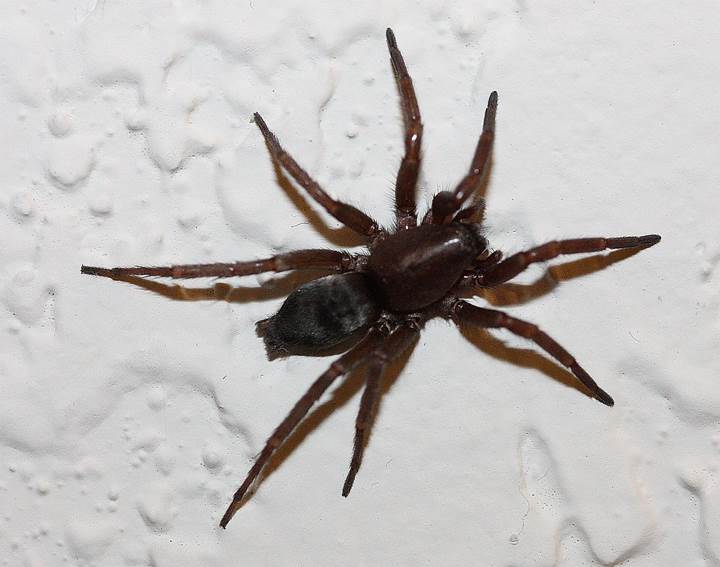
Probably Scotophaeus blackwalli (Ara.: Gnaphosidae) Jeremy Tatum
Jeremy also photographed a caddisfly in the building. There is usually an expert in any obscure subject out there somewhere – so is there someone who can identify the caddisfly for us?
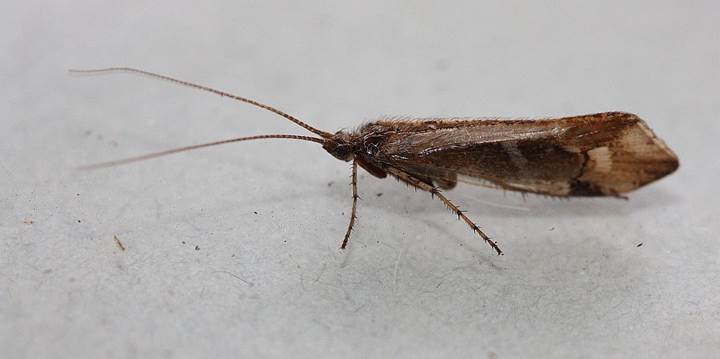
Caddisfly (Trichoptera) Jeremy Tatum
2014 October 22
Mike Yip writes that his book VANCOUVER ISLAND BUTTERFLIES is currently at the printers in Altona, Manitoba and should be available by Nov. 7. Mike is the principal author and photographer, and James Miskelly collaborated with the updated distribution maps for all 70 species on the Island list. The book is full colour, hard cover, 128 pages, and will be available in some bookstores (Munro’s and Tanners so far) for $34.95 plus GST. However, naturalists and butterfly enthusiasts can get their copies for $25 each if someone is willing to collect cheques, make a group order, and hold the books for pick up. Email Mike if anyone is interested (mikyip@hotmail.com).
Jeff Gaskin writes: On October the 21st, there were two Cabbage Whites along Maddock Avenue at Qu’appelle Avenue. [Only a few more days now before November – can we extend the butterfly season into that month? – Jeremy Tatum]
At last we have managed to identify the caterpillars found by Gwen Greenwood (2011 November 11) and Bud Logan (2012 October 12). On October 19 Jeremy Gatten found a similar one in Devonian Park and he found a description (no picture!) of it in a 1958 Proceedings of the Entomological Society of British Columbia. It is Lophocampa roseata.
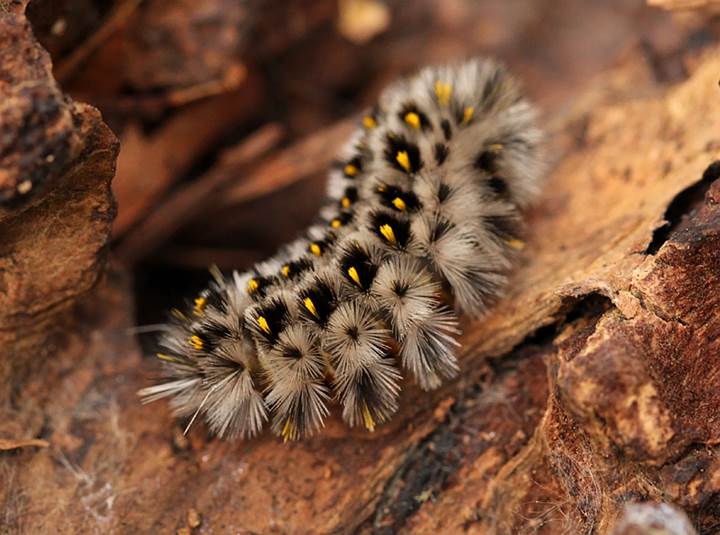
Lophocampa roseata (Lep.: Erebidae – Arctiinae) Jeremy Gatten
Jeremy Gatten also found two individuals of Orthosia mys at his Saanichton house a few days ago. It is of interest to compare this moth with photographs of the somewhat similar Orthosia transparens which appeared on this site for 2011 April 6 and 24, and 2013 March 30.
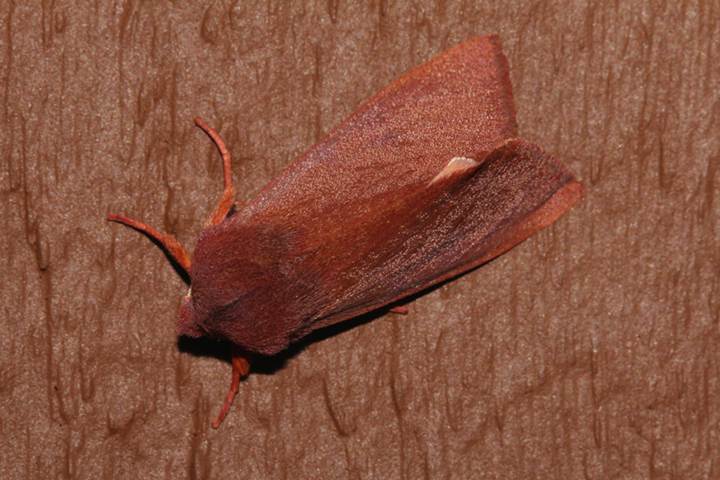
Orthosia mys (Lep.: Noctuidae) Jeremy Gatten
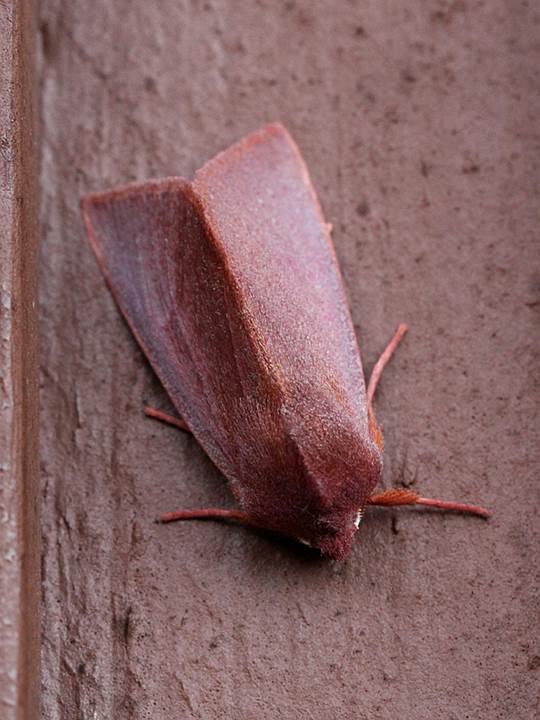
Orthosia mys (Lep.: Noctuidae) Jeremy Gatten
2014 October 20
Jeremy Tatum reports a Cabbage White from Island View Road on October 19. I wonder if we can extend the butterfly season into November?
Jeremy shows a photograph of a White-lined Hawk Moth from Martindale Flats, October 19.
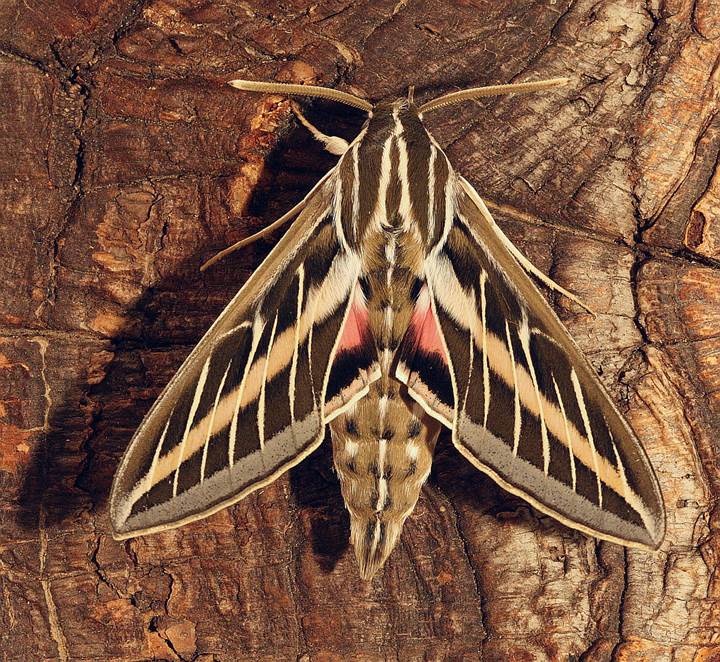
White-lined Hawk Moth Hyles lineata (Lep.: Sphingidae) Jeremy Tatum
Gordon Hart writes: We saw one Cabbage White in the Highlands today October 18, and one day-flying moth. I think it is Autographa californica as per your book (http://facweb.furman.edu/~snyderjohn/tatum/) and Bill Katz’s picture of September 23. [See also Aziza Cooper’s of August 9 – Jeremy.] It landed first on some yellow chrysanthemums and then on dandelions. Your book says it is migratory but I’m afraid this one won’t be going anywhere. Just as I was framing another shot, a junco swooped in and grabbed it for a snack. Jeremy Tatum responds: Yes, Bill Savale and I also saw several Cabbage Whites in the Vantreight Central Saanich fields on October 18, as well as an equally incautious Autographa californica. It was so intent on nectaring on Raphanus that it allowed me to catch it in a jar to verify the identification, before releasing it.
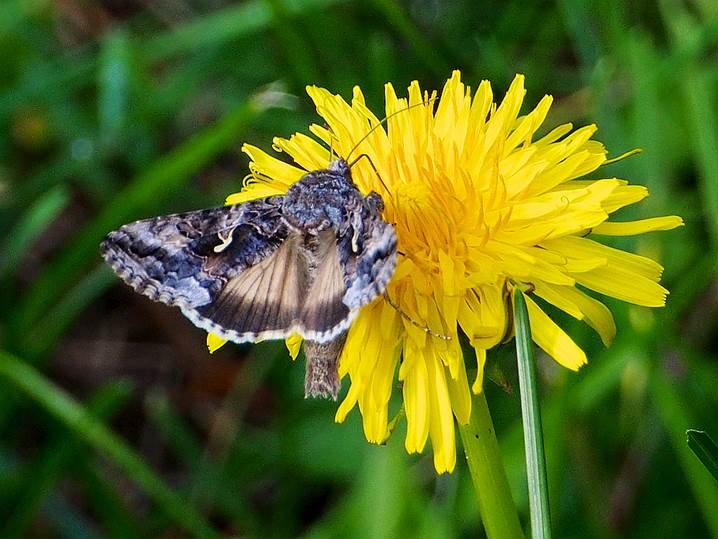
Autographa californica (Lep.: Noctuidae) Gordon Hart
Bill Katz writes: The walls of the Goldstream Nature House were a moth paradise on Saturday morning, October 18. I identified Epirrita autumnata and Tetracis jubararia [also known as Synaxis jubararia – Jeremy].
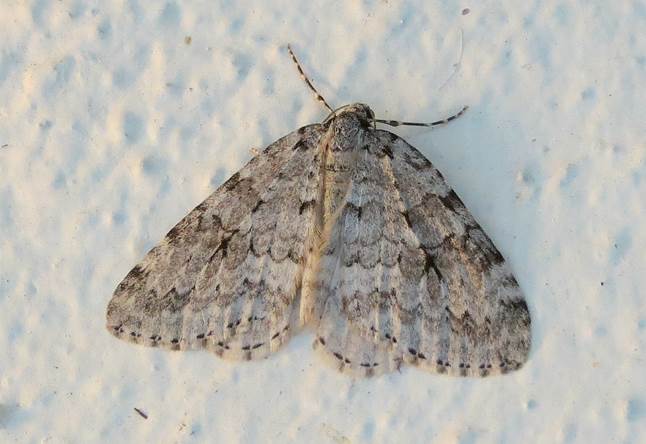
Autumnal Moth Epirrita autumnata (Lep.: Geometridae) Bill Katz
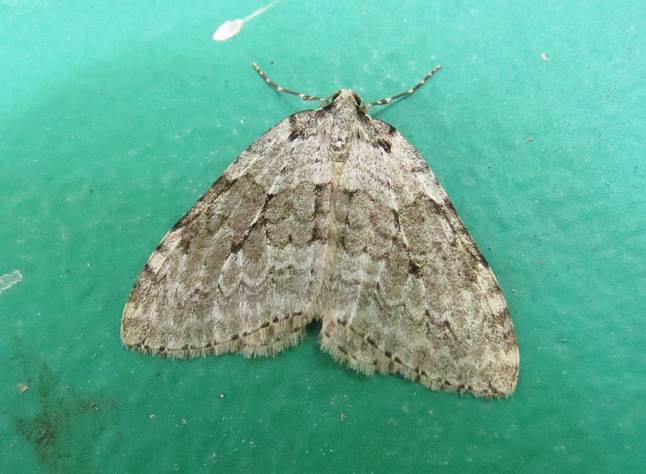
Autumnal Moth Epirrita autumnata (Lep.: Geometridae) Bill Katz
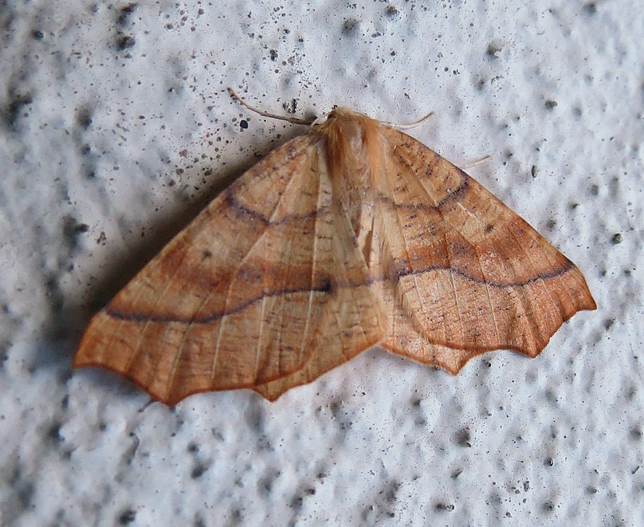
October Thorn Tetracis jubararia (Lep.: Geometridae) Bill Katz
2014 October 17
Daniel Dönnecke sends a photograph of a yellow underwing moth Noctua sp. from Swan Lake, October 16. The clear absence of a dark crescent in the middle of the hindwing shows that it is in fact the Large Yellow Underwing Noctua pronuba rather than the somewhat similar Lesser Yellow Underwing Noctua comes.
Viewers may also notice a bird in the photograph. It is a Tropical Kingbird Tyrannus melancholicus (Pas.: Tyrannidae).
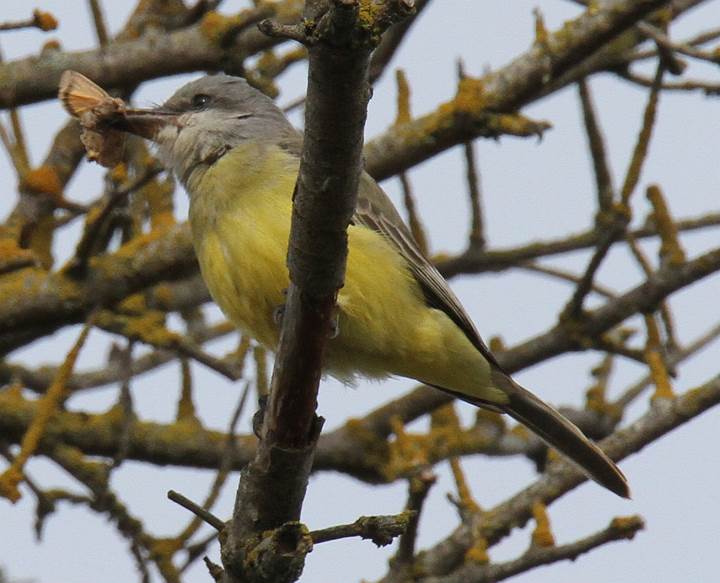
Large Yellow Underwing Noctua pronuba (Lep.: Noctuidae) Daniel Dönnecke
2014 October 15
Jeremy Tatum saw a Cabbage White outside his Saanich apartment on October 11.
He found another Autographa californica caterpillar, at Martindale Flats, October 12, feeding upon Raphanus. And there are lots of Isabella caterpillars (Banded Woolly Bears) around, especially at Panama Flats and Swan Lake, where the one below was found.
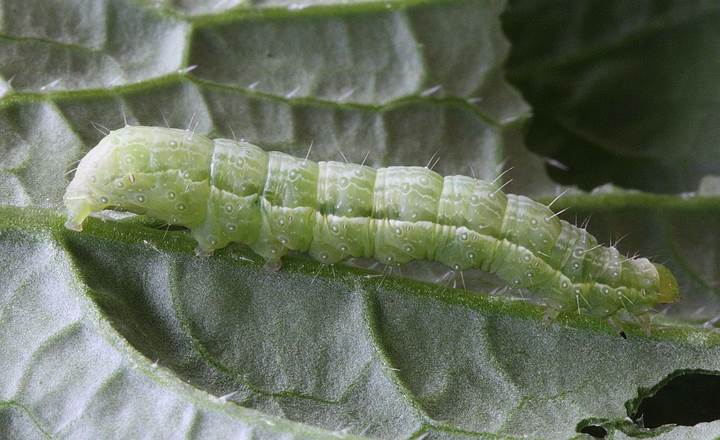
Autographa californica (Lep.: Noctuidae) Jeremy Tatum
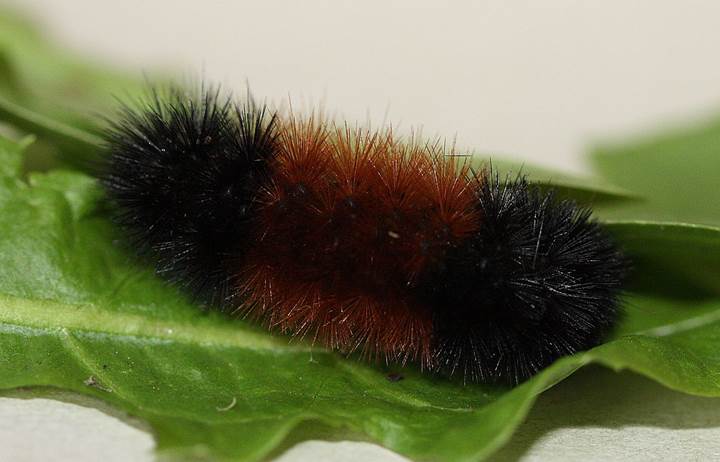
Banded Woolly Bear Pyrrharctia isabella (Lep.: Erebidae – Arctiinae) Jeremy Tatum
These caterpillars are very attractive and visible at this time of year, and I dare say some viewers may be tempted to keep one to see what sort of moth eventually emerges. This is an interesting thing to do, but maybe it is worth knowing, for those who haven’t reared many moths from caterpillars, that Pyrrharctia isabella is not an easy caterpillar to rear – indeed one might say it is one of the more difficult ones – and perhaps not to be recommended for a first attempt. One problem is that it will not pupate until about next March, and it won’t eclode until May, so you’d have to look after it all winter. You may be able to find one outside in February – and then they are much easier. If you are curious to see what the adult looks like, there are photographs on this site for May 25, 2010 and 2012. May 25 seems to be a good date to find the adult!
Caterpillars are not the only things that creep and crawl.. Here is a slug from the garden of my apartment, October 11.
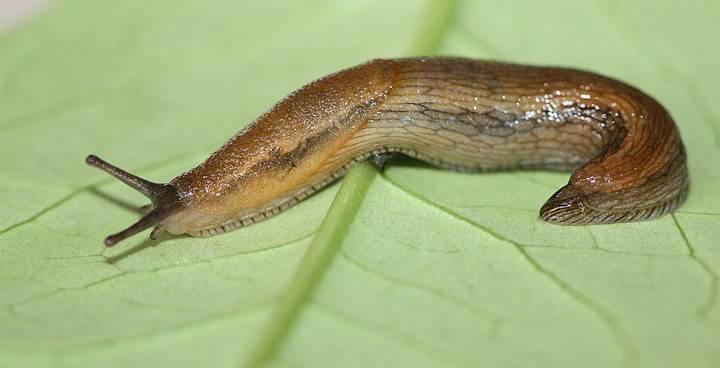
Arion subfuscus (Pul.: Arionidae) Jeremy Tatum
Bill Katz sends a photograph of an October Thorn Synaxis jubararia [also known as Tetracis jubararia – I’m not sure what its name is this year — Jeremy] from his productive Summit Hill garage.
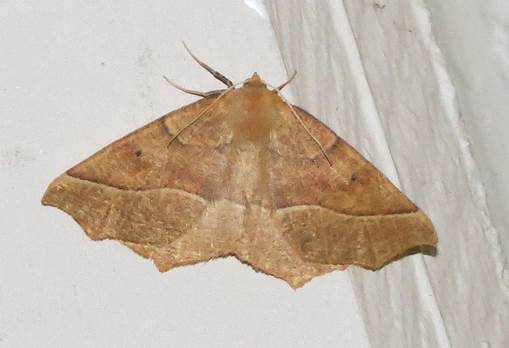
October Thorn Tetracis jubararia (Lep.:Geometridae) Bill Katz
2014 October 10
Jeff Gaskin writes: There were over 10 Banded Woolly Bears at Panama Flats on Tuesday October 7. Last year, if I recall, there was a huge number of Banded Woolly Bears here too. [Yes – that’s what I remember, too. – Jeremy]
There are other caterpillars still to be found. The one shown below was found at McMicking Point on October 5. It is Autographa californica. It is a plusiine. That is to say it belongs to the subfamily Plusiinae of the family Noctuidae. The caterpillars of most plusiines are “semi-loopers”. They have only two pairs of mid-abdominal prolegs rather than the usual four.
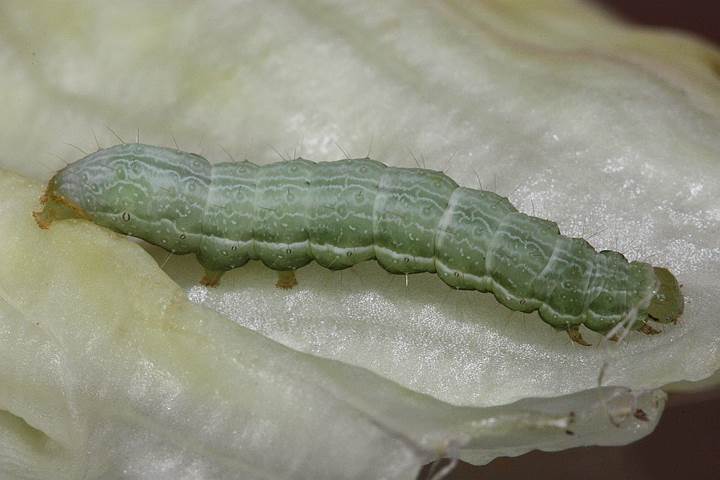
Autographa californica (Lep.: Noctuidae – Plusiinae) Jeremy Tatum
Jeremy Tatum writes: Here are two moths from my Saanich apartment on October 10. One is the abundant European Large Yellow Underwing. The other is a species of Drepanulatrix. I have had difficulties with the identification of Drepanulatrix moths before and I may have to revisit previous images of this genus in the Website. However, I am pretty sure the moth shown below is Drepanulatrix monicaria, although, strangely, this species does not appear to be on the Lafontaine/Troubridge list for Canada, at least not under this name.
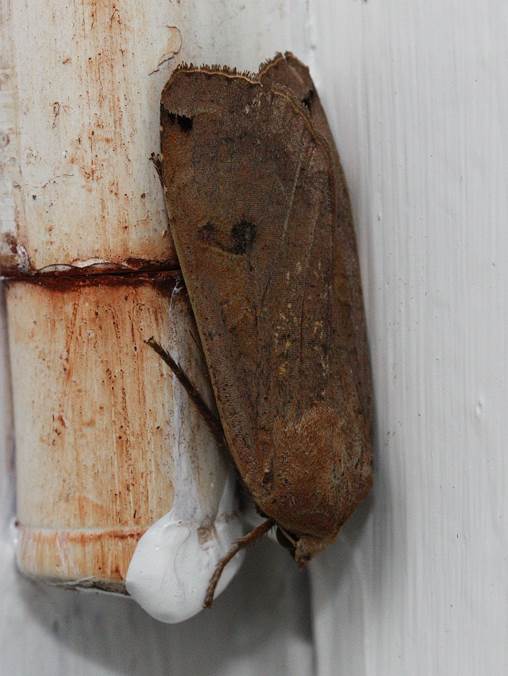
Noctua pronuba (Lep.: Noctuidae) Jeremy Tatum
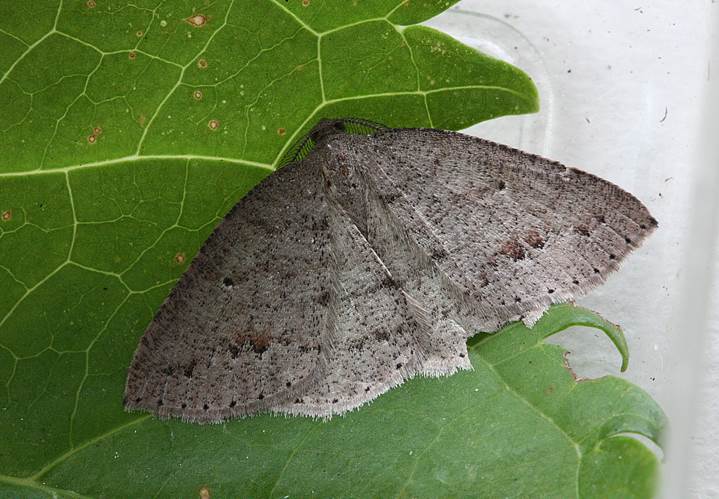
Drepanulatrix monicaria (Lep.: Geometridae) Jeremy Tatum
2014 October 7
Val George writes: Here is another nice fresh Painted Lady, this one seen at Cattle Point, October 7, with the Tuesday birding group. I got a photo of this one.
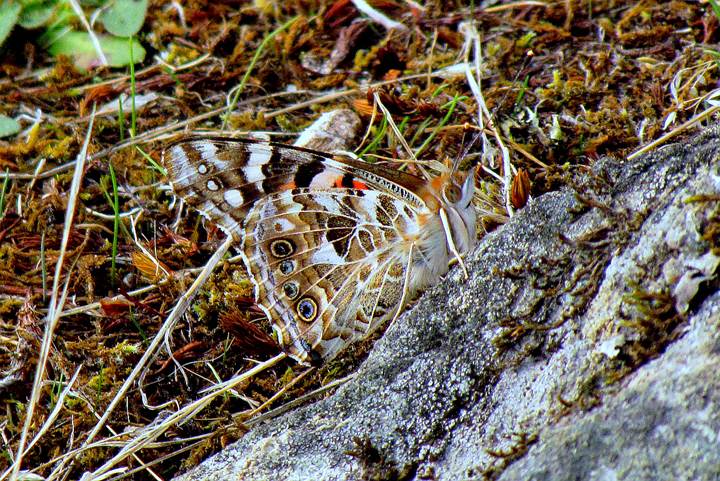
Painted Lady Vanessa cardui (Lep.: Nymphalidae) Val George
Jeremy Tatum writes that there were still lots of Cabbage Whites around on October 6. The caterpillar season isn’t quite over yet. October is the month to see caterpillars of the Banded Woolly Bear – I saw several at Swan Lake on October 6. And I spotted an interesting caterpillar, shown below, below on Cornus stolonifera at Swan Lake on October 5. The sharply contrasting colours disguise the (already weird) shape of the caterpillar. This is called disruptive coloration.
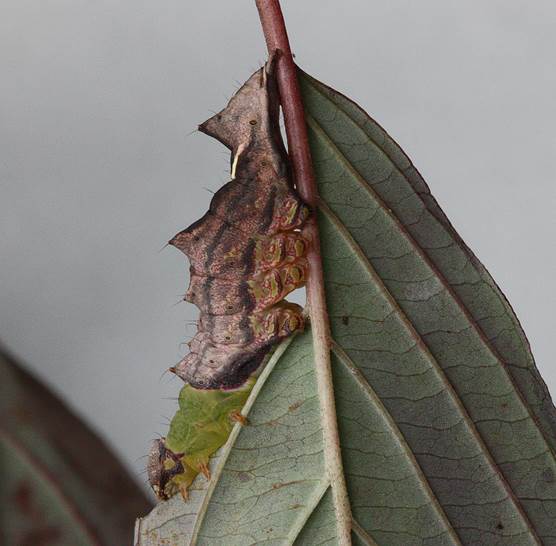
Unicorn Prominent Schizura unicornis (Lep.: Notodontidae)
Jeremy Tatum
2014 October 4
Val George writes: On October 1 there was a Painted Lady near Willows Beach in Oak Bay. It looked to be in very fresh condition. That’s the fourth Painted Lady reported from the Greater Victoria area since September 21. All have been reported as in fresh condition.
Jeremy Tatum sends photographs, both taken on October 3, of two moths new to this site. The first, from his Saanich apartment, is a White-speck Moth Mythimna unipuncta (formerly known as Pseudaletia unipuncta, and, before that, as Leucania unipuncta.) The caterpillar is known to agriculturists as the Army Worm and in some places it apparently occurs in huge numbers and can be destructive to crops. Jeremy writes: I have rarely seen the moth here, and I have yet to find the caterpillar. For a time, he continues, I was sure the second moth, from Swan Lake, was a notodontid – perhaps Schizura or Oligocentria. But it isn’t – it’s a noctuid, which looks very like a notodontid. That big reniform stigma (that’s Latin and Greek for kidney-shaped spot) gives it away as a noctuid.. It is in fact the noctuid Lithomoia germana, the American Brindle. If Schizura imitates a stick, does Lithomoia imitate Schizura imitating a stick? Is it an example of convergent evolution?
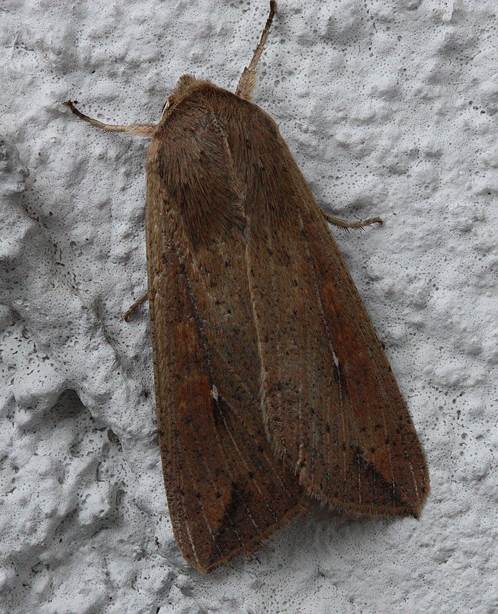
White-speck Mythimna unipuncta (Lep.: Noctuidae)
Jeremy Tatum
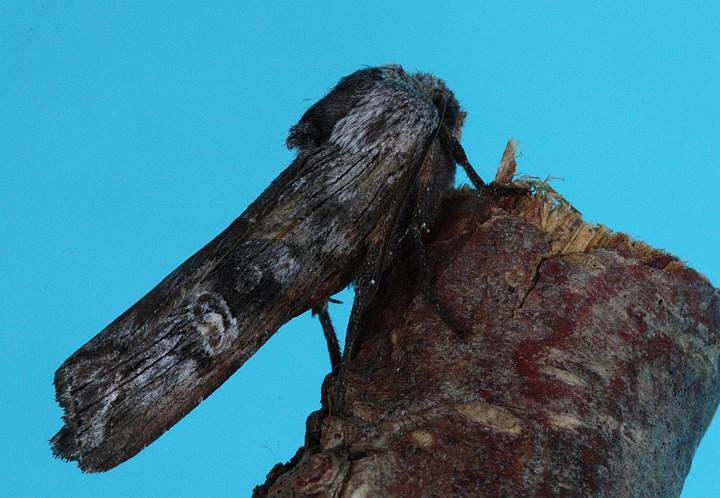
American Brindle Lithomoia germana (Lep.: Noctuidae) Jeremy Tatum
2014 October 01
Butterflies may be getting scarce, but there are still lots of other invertebrates to see, such as this slug that Jeremy Tatum photographed at Mount Douglas Beach Park today.
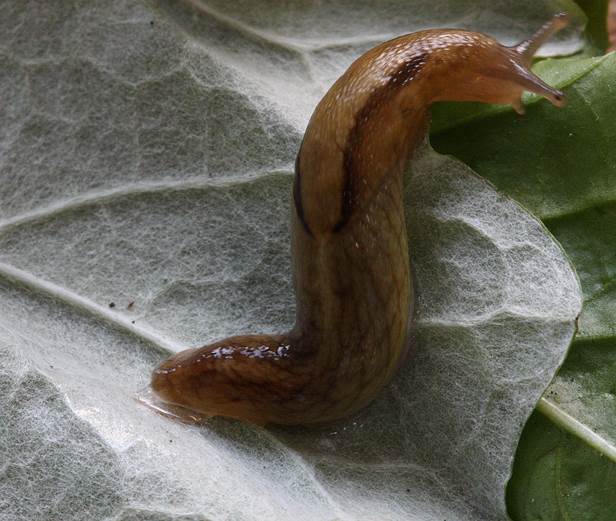
Reticulated Tail-dropper Prophysaon andersonii (Pul.: Anadeniidae) Jeremy Tatum
Jeremy Tatum reports a Painted Lady from Iron Mine Bay, September 28. He shows an Apple-and-Thorn Skeletonizer moth, which came from the caterpillar shown on September 18.
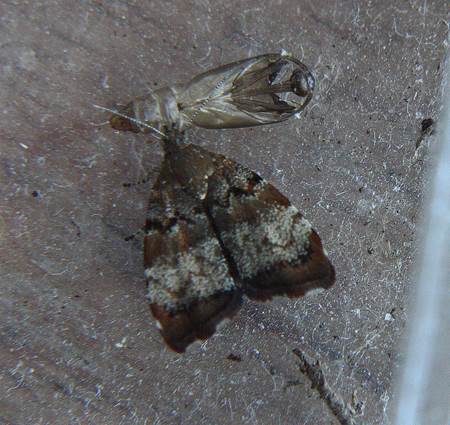
Apple-and-Thorn Skeletonizer Choreutis pariana
(Lep.: Choreutidae)
Jeremy Tatum
2014 September 27
The butterfly season is drawing to a close, but there are still a few surprises. Jeremy Tatum reports a Lorquin’s Admiral from Swan Lake, and Ken Vaughan photographed a Painted Lady at Esquimalt Lagoon, both on September 27. There are still a few Cabbage Whites around. Who is going to see the last one?
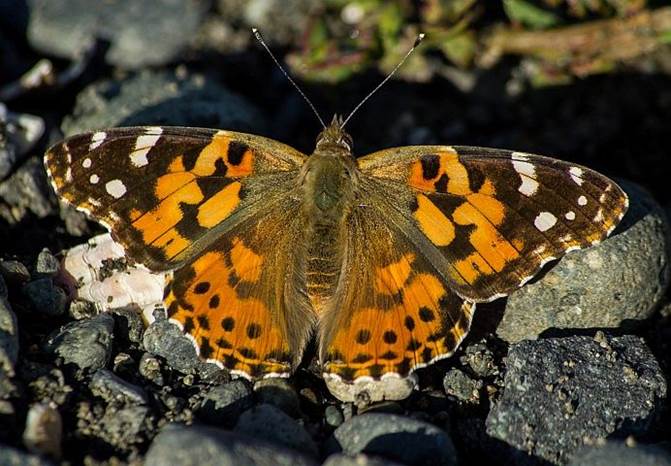
Painted Lady Vanessa cardui (Lep.: Nymphalidae) Ken Vaughan
Bill Katz sends a picture of a beautiful noctuid moth (new to this site) from Goldstream, and a spectacular coreid bug from Swan Lake.
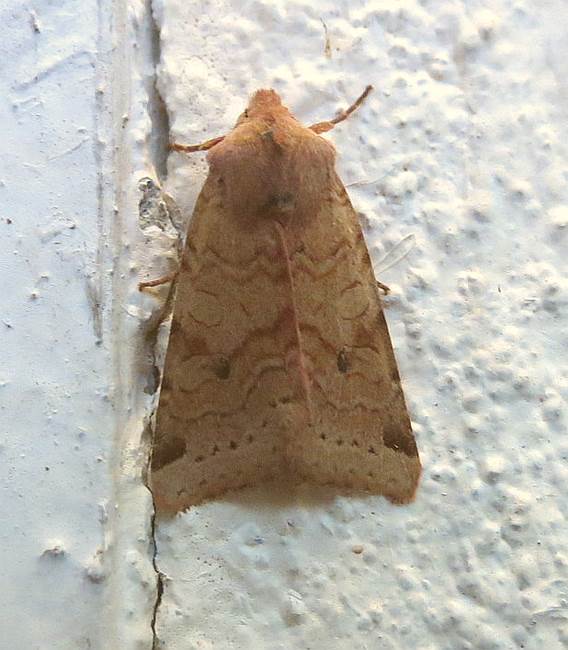
Agrochola purpurea (Lep.: Noctuidae) Bill Katz
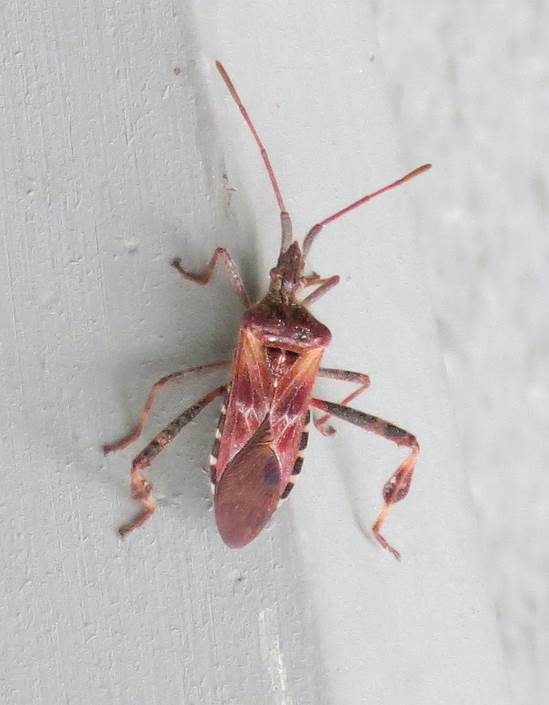
Western Conifer Seed Bug Leptoglossus occidentalis (Hem.: Coreidae)
Bill Katz
Val George sends a couple of photos from Island View Beach, September 25: a Western Black Widow, Latrodectus hesperus (also new to this site) and a Banded Woolly Bear (Isabella Moth) Pyrrharctia isabella.
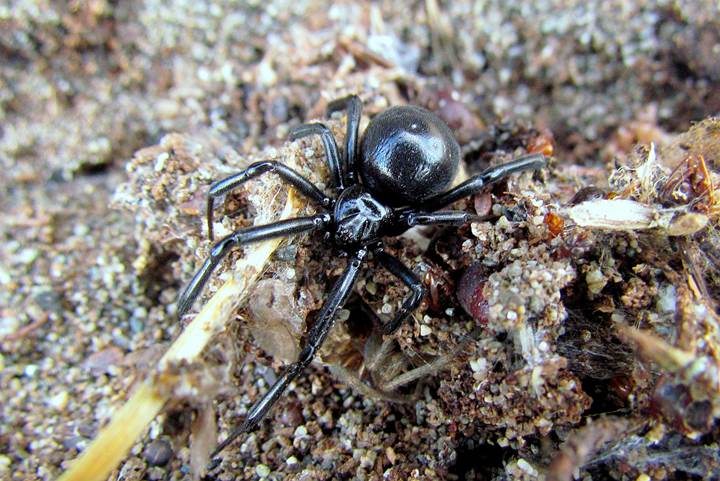
Western Black Widow Latrodectus hesperus (Ara.: Theridiidae) Val George
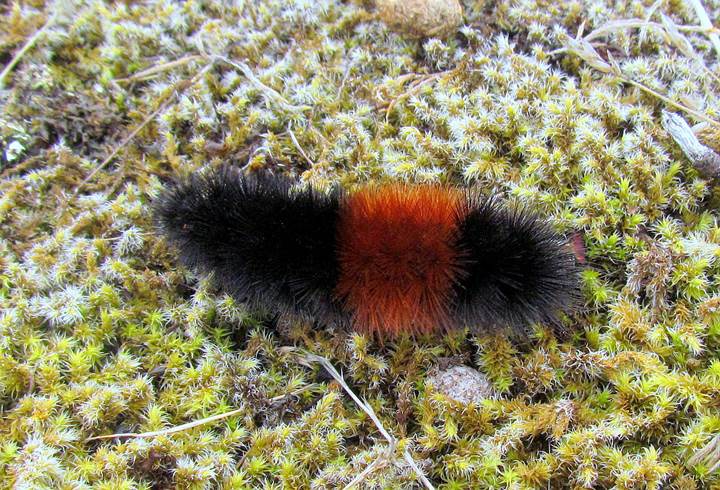
Banded Woolly Bear Pyrrharctia isabella (Lep.: Erebidae – Arctiinae) Val George
2014 September 23
Gordon Hart sends photographs from the Highlands of Noctua pronuba and Nepytia phantasmaria. The former is a European invader, which has rapidly become one of our most familiar moths in Victoria. Its caterpillar feeds on many low-growing plants, especially those that you are trying to grow in your garden. The caterpillar of the latter is a conifer-feeder.
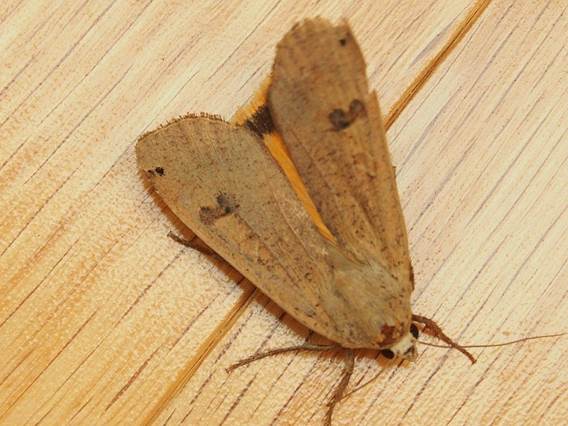
Large Yellow Underwing Noctua pronuba (Lep.: Noctuidae) Gordon Hart
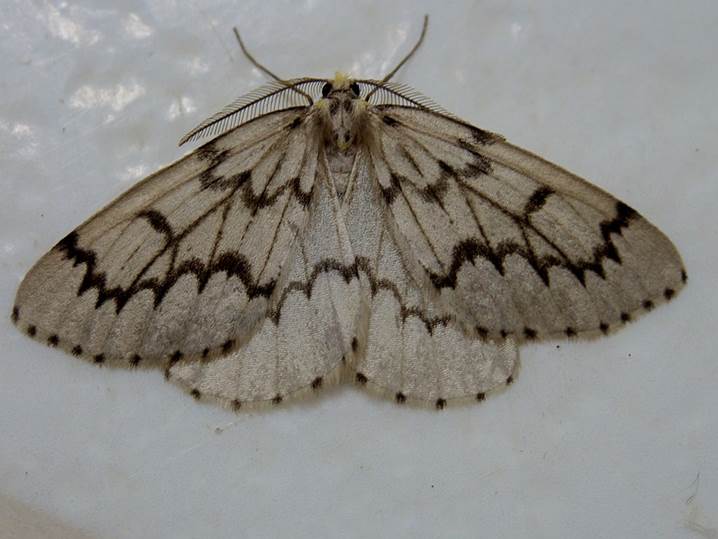
Nepytia phantasmaria (Lep.: Geometridae) Gordon Hart
Goldstream Park is very productive for moths at the moment – especially around the Nature House. Bill Katz photographed an interesting caterpillar on September 20. David Wagner identified this one for us as a species of Zale. It is most likely Z. lunata. The brown colour probably indicates that it is shortly going to pupate.
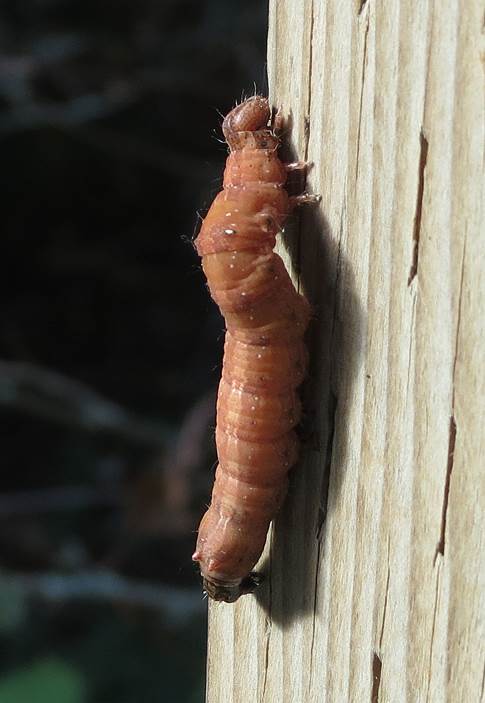
Zale (probably lunata) (Lep.: Erebidae -Erebinae) Bill Katz
Next is Papaipema insulidens, whose caterpillar is a stem-borer in ragwort.
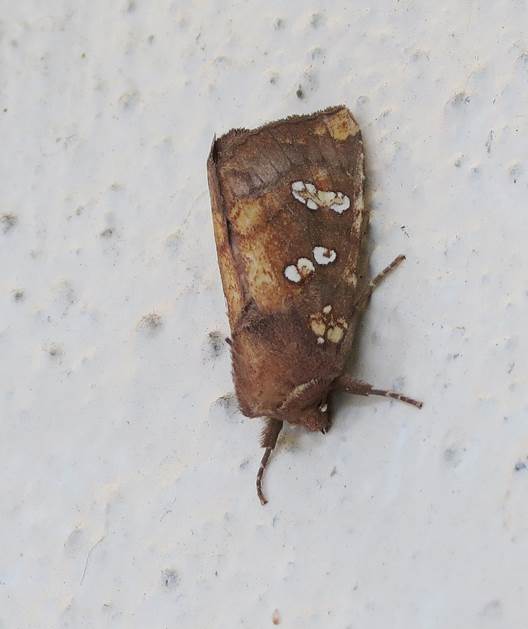
Papaipema insulidens (Lep.: Noctuidae) Bill Katz
Next is a more familiar moth, the day-flying Autographa californica.
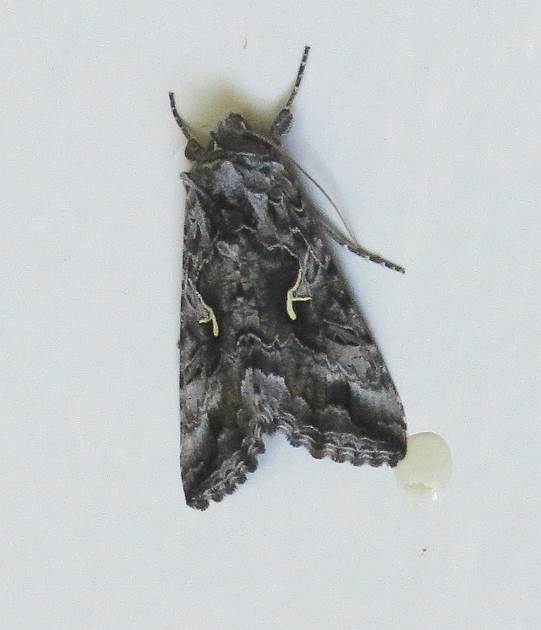
Autographa californica (Lep.: Noctuidae) Bill Katz
And now Lithophane pertorrida, which is interesting, because it was shown previously on this site on April 3 of this year. This may be a species that overwinters in the adult state and hence can be found is spring and in fall.
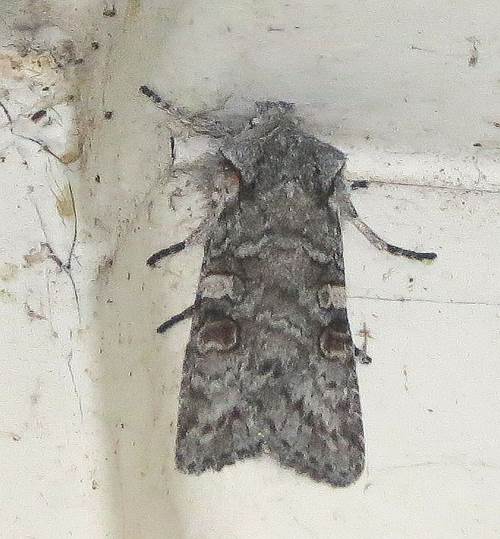
Lithophane pertorrida (Lep.: Noctuidae) Bill Katz
And Bill got one more interesting moth from Finnerty Gardens at UVic on September 20. Thanks to Libby Avis for identifying it for us as Pleromelloida cinerea.
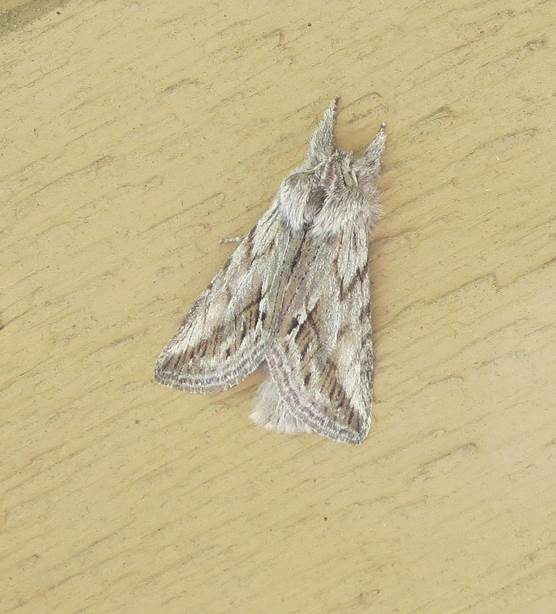
Pleromelloida cinerea (Lep.: Noctuidae) Bill Katz
Jeremy Tatum writes: Here is a Heliothis phloxiphaga from Gumweed at Island View Beach, and a micro, Oreana unicolorella from willow at Munn Road. The caterpillars of these species are shown on the postings for August 22 and September 18 respectively.
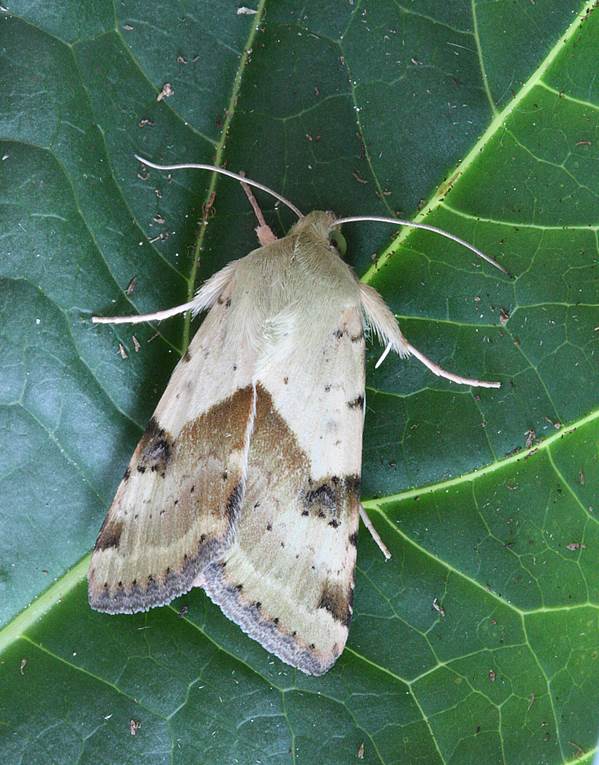
Heliothis phloxiphaga (Lep.: Noctuidae) Jeremy Tatum
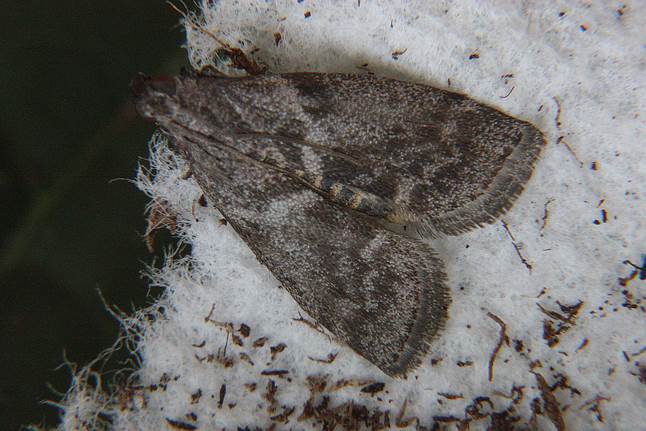
Oreana unicolorella (Lep.: Pyralidae) Jeremy Tatum
Jeremy Tatum writes that he went to Martindale Road on September 21 to see if there were still any Orange Sulphurs there. He didn’t see any, but it might still be worth trying. He did see a pristine fresh Painted Lady there, next to the same corn square where the sulphurs had been. And Aziza Cooper reports that a Mourning Cloak flew by the VNHS barbecue at the Aylard Farm parking lot on September 20.
2014 September 20
Saturday, September 20 to Sunday September 28
EVENT
Victoria Butterfly Count
We are always looking for keen-eyed volunteers to submit butterfly records. If you would like to participate, please contact Aziza Cooper at tanageraz at yahoo.com.
Annie Pang sends a poetogram of Neoalcis californiaria from the Gorge area.
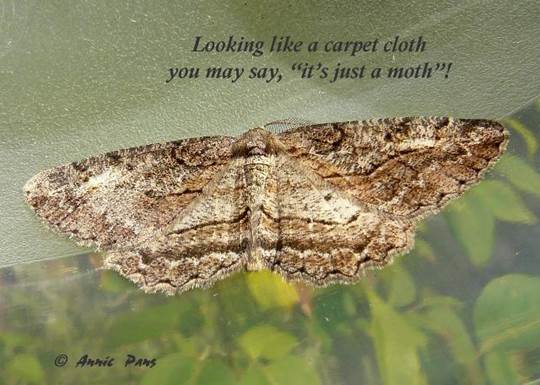
Neoalcis californiaria (Lep.: Geometridae) Annie Pang
Jeremy Tatum sends a photograph of a bug found in his Saanich apartment, September 19, and a caterpillar found on Hardhack at Swan Lake, September 20. He writes that on September 20 he saw a Purplish Copper and several Cabbage Whites on the East Saanich Indian Reserve.
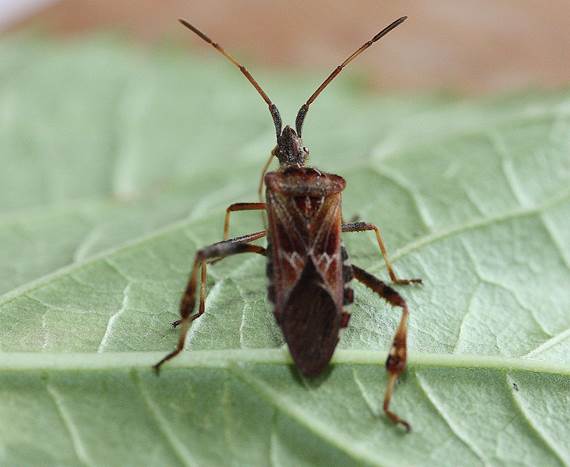
Western Conifer Seed Bug Leptoglossus occidentalis (Hem.: Coreidae)
Jeremy Tatum
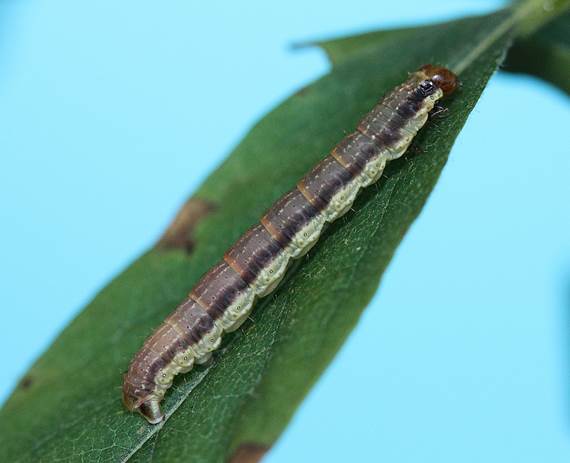
Rheumaptera undulata (Lep.: Geometridae) Jeremy Tatum
2014 September 18
Libby Avis writes: I found a Cisseps fulvicollis, Yellow-collared Scape Moth, at Little Qualicum Estuary September 15th.
Jeremy Tatum comments. This is one of the most striking of the tribe Lithosiini of moths variously known as scape moths or footman moths. The caterpillars (I have never found one!) feed on lichens.
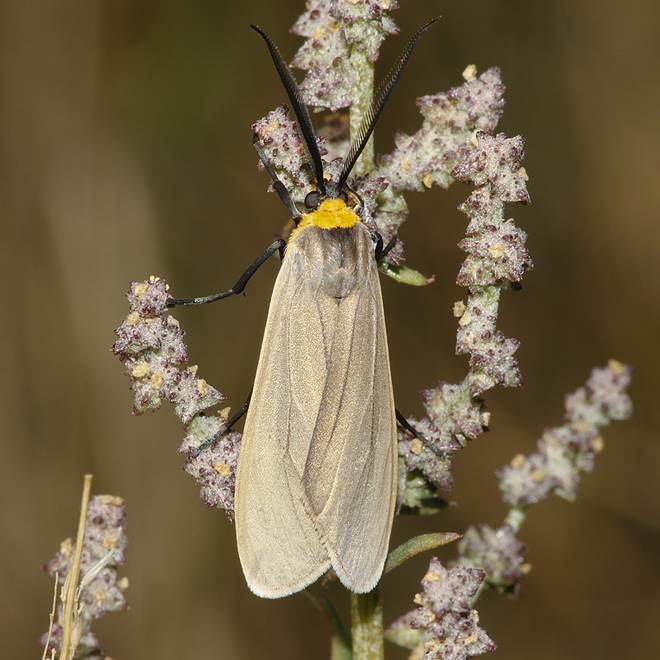
Yellow-collared Scape Moth Cisseps fulvicollis
(Erebidae – Arctiinae – Lithosiini)
Libby Avis
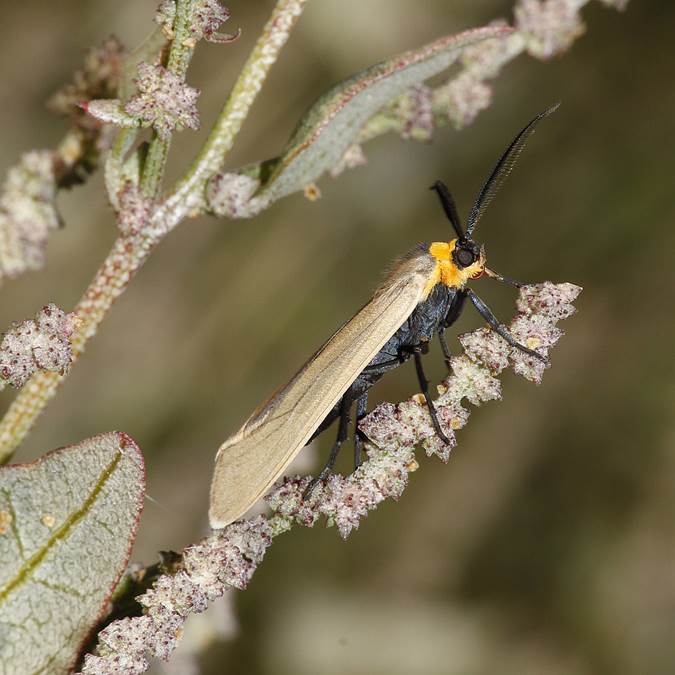
Yellow-collared Scape Moth Cisseps fulvicollis
(Erebidae – Arctiinae – Lithosiini)
Libby Avis
Jeremy Tatum writes: Here is the moth Lacanobia subjuncta from Beckwith Park in Saanich, September 16. Thanks to Libby for the identification.
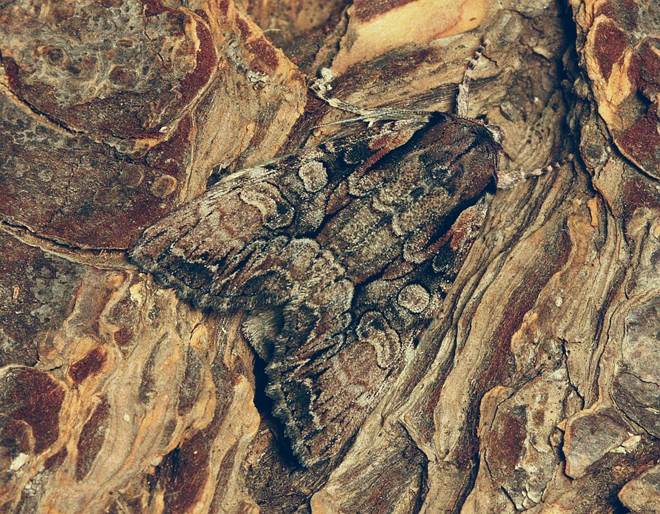
Lacanobia subjuncta (Lep.:Noctuidae) Jeremy Tatum
Guy Monty sends photos of a Catocala. He writes: On the evening of September 14, 2014, there were about two dozen of them fluttering around our porch lights here in Moorecroft Regional Park, Nanoose Bay.
Jeremy Tatum responds: We are not sure what species it is. You’d think a striking species like this would be easy, but Catocala is a large genus with lots of similar-looking species. Discussions have included as possibilities Catocala aholibah, allusa, semirelicta, unijuga. Who knows? For the time being we’d better settle for Catocala sp.
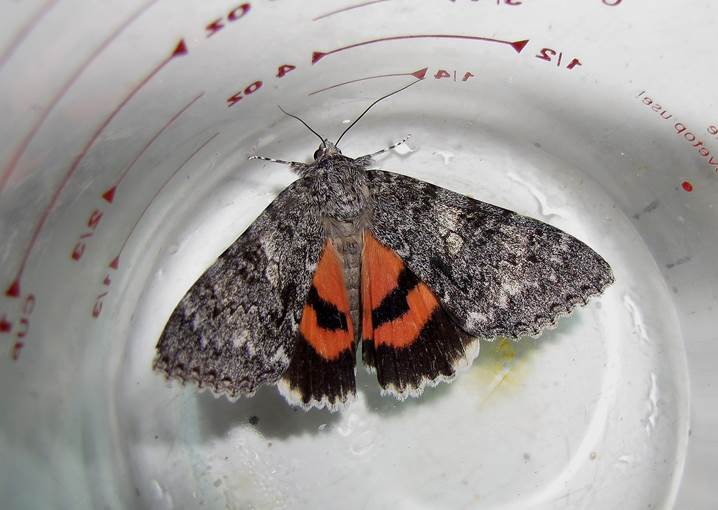
Catocala sp.(Lep.: Erebidae – Erebinae – Catocalini) Guy Monty
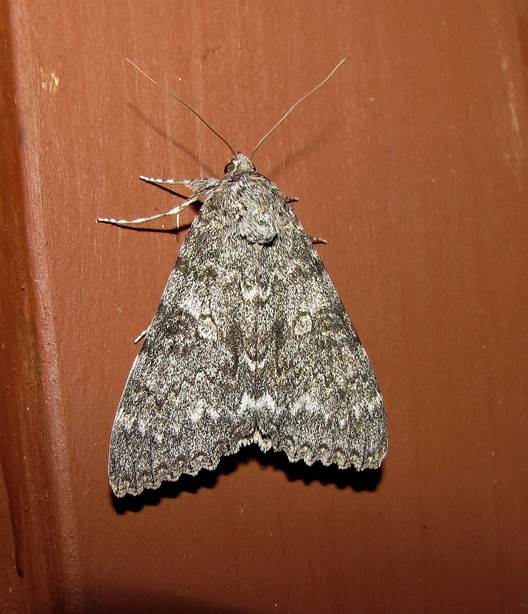
Catocala sp.(Lep.: Erebidae – Erebinae – Catocalini) Guy Monty
Jody Wells writes: I saw this remarkable butterfly on my property on West Saanich Road earlier this summer (1st or 2nd August). It was gorgeous blue on the upperside of the wings, and although it flew around landing on this same spot a few times I couldn’t get a shot showing colour. I’m not sure if this is a common species or not. I do not recall ever having seen this large beautiful butterfly in the 35 years I have lived in Greater Victoria.
Jeremy Tatum responds: Glad you mentioned the blue on the upperside, otherwise I would have been stumped. This is Morpho peleides, which occurs in Costa Rica and at the Butterfly Gardens in Central Saanich! Looks as though it had made a break for it.
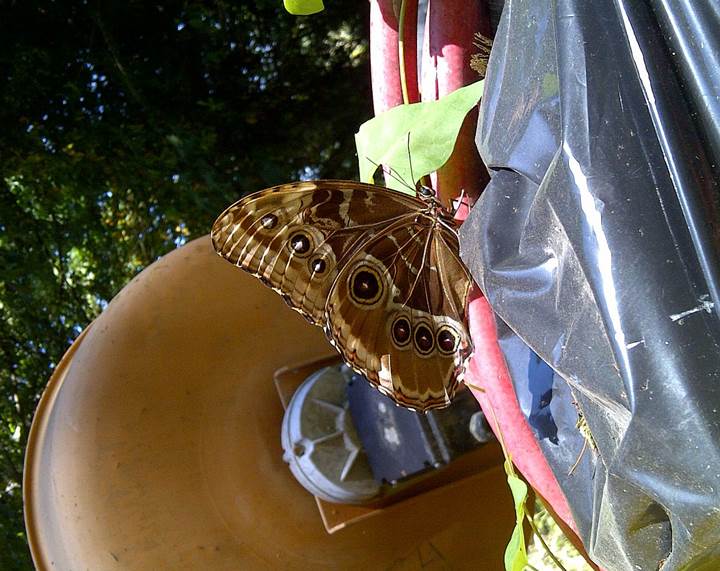
Morpho peleides (Lep.: Nymphalidae) Jody Wells.
Reid and Susan Gurney write from Fanny Bay in the Comox Valley: Here is a large caterpillar (approx. three inches long by one half inch wide) which we saw on our lawn one week ago. Jeremy Tatum writes: It is the caterpillar of the Polyphemus Moth. Viewers can keep a look out for this spectacular creature just now, when most of them are full grown,
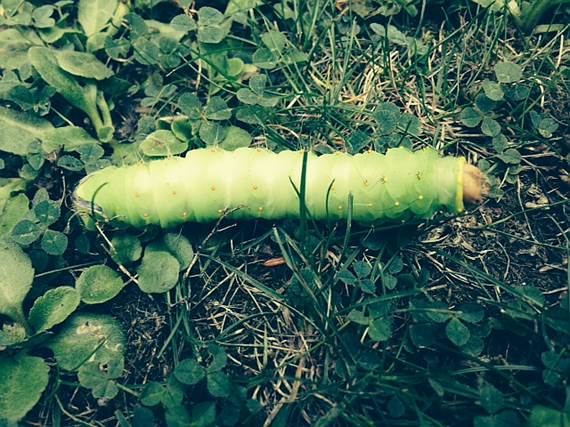
Polyphemus Moth Antheraea polyphemus (Lep.: Saturniidae)
Reid and Susan Gurney
And now for some micros. We are much indebted to Eric LaGasa for identifying them.
First a small moth, several of which have been outside Jeremy Tatum’s Saanich apartment in recent days. It is a European species, Acleris rhombana, apparently known in North America only from British Columbia. Bill Katz photographed one for Invert Alert on October 18, 2013.
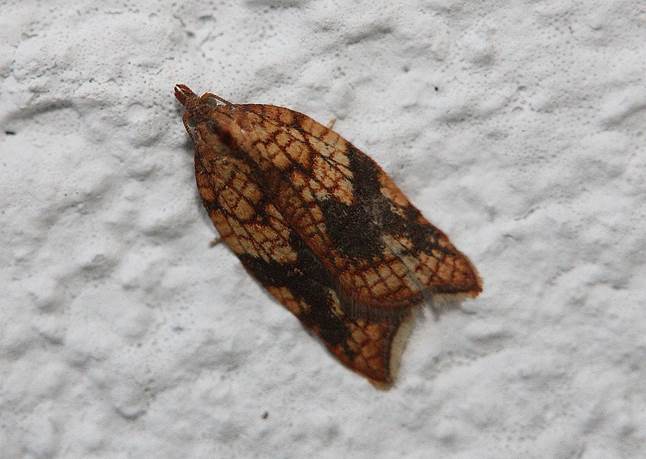
Acleris rhombana (Lep.: Tortricidae) Jeremy Tatum
Next, two well-marked micro caterpillars. The first was on Salix at Munn Road. It is probably Oreana unicolorella. The second was on Malus at Witty’s Lagoon. It is the Apple-and-Thorn Skeletonizer Choreutis pariana.
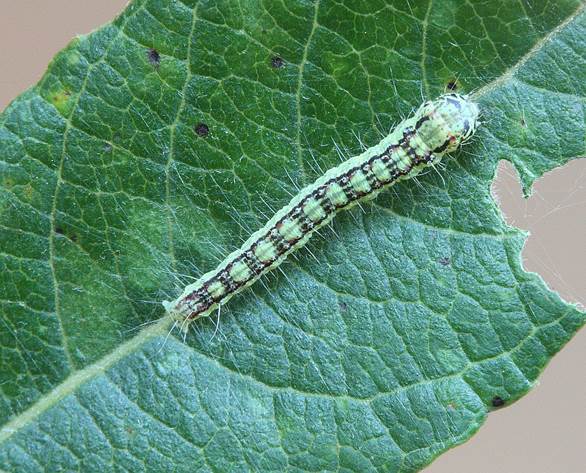
Oreana unicolorella (Lep.: Pyralidae) Jeremy Tatum
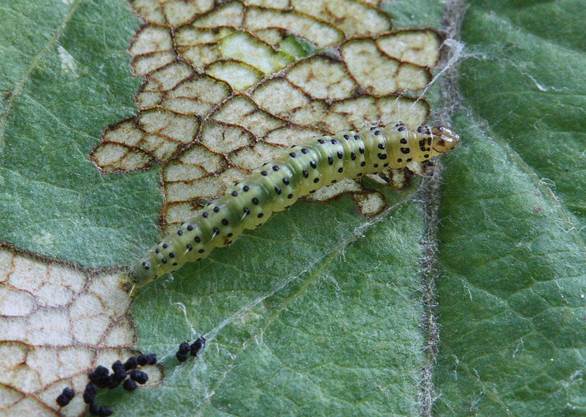
Choreutis pariana (Lep.: Choreutidae) Jeremy Tatum
2014 September 16
There still seem to be a few Pine Whites around, especially in the Sooke/Metchosin area. Jeff Gaskin writes that there was one at Whiffin Spit and one seen along Sooke Road rear Gillespie Road on September 13. Jeremy Tatum saw several on September 14 at Swanwick Road and at Pearson College, Metchosin. Some were high up in the trees; others were nectaring near ground level on thistles and hawkbits.
Val George writes: This morning, Sept 14, a Sulphur butterfly flew in front of my car as I was driving along Oak Bay Ave. Needless to say, I couldn’t identify the species.
Annie Pang sends a photograph of a noctuid moth from the Gorge area, September 12. Thanks to Libby Avis for identifying it as Homorthodes communis.
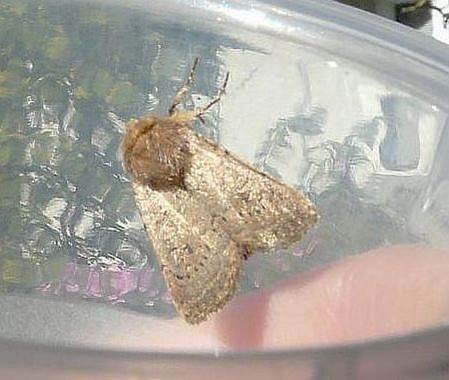
Homorthodes communis (Lep.: Noctuidae) Annie Pang
Jeremy Tatum sends a photograph of Tetracis jubararia from Bow Park, Saanich, September 15.
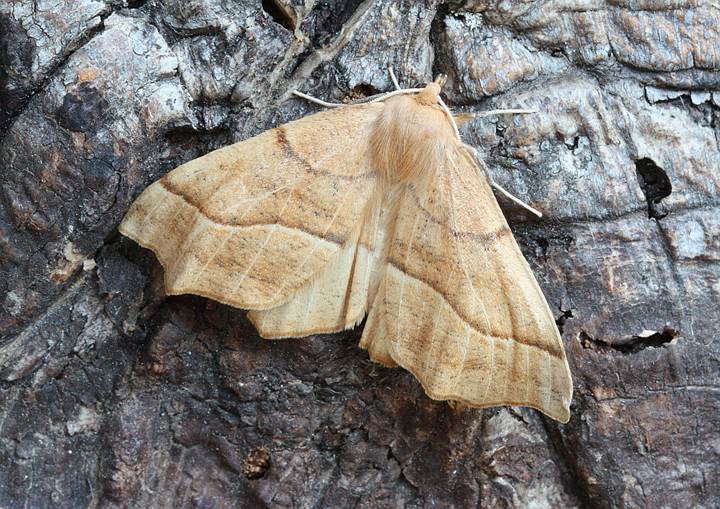
Synaxis jubararia (Lep.: Geometridae) Jeremy Tatum
2014 September 13
Libby Avis writes from Port Alberni: Just checked the VNHS site and see you have a post for Neoarctia brucei from Campbell River. We were particularly interested because Rick photographed two of them on Mt Adder, near Sutton Pass, between Ucluelet and Port Alberni, on August 1. Haven’t seen one before, so maybe this is a good year for them.
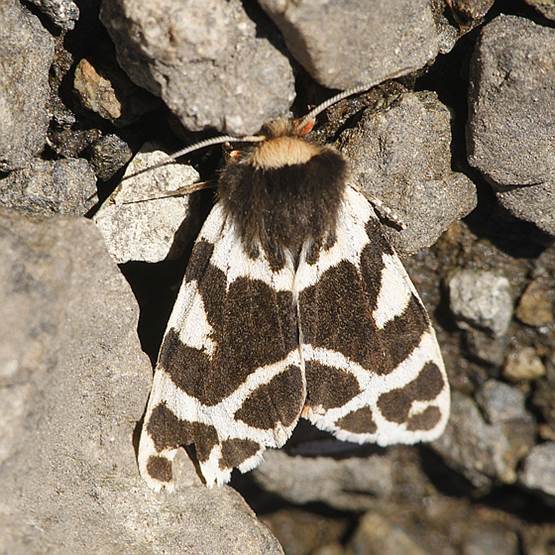
Neoarctia brucei (Lep.: Erebidae – Arctiinae) Rick Avis
Libby continues: I was wondering if you have any ideas on a couple of caterpillars from earlier in the year. The first one was found in our yard on August 20th and looks as if it might be a Lasiocampidae. The red markings behind the head are similar to Phyllodesma americana, although the other markings are the wrong colour. [Jeremy Tatum comments – I agree. I’m sure it’s Phyllodesma americana, though I’ve never seen one with those markings or colours – apart from the red rings on the thorax, which look typical.]
The second was found on Purple Loosestrife on the Somass Estuary on June 20th. I posted it on Bug Guide and got a suggestion back that it was perhaps an Egira. [Jeremy comments: I think it is a noctuid, and I agree that it is probably an early instar of a species of Egira, perhaps E. crucialis.]
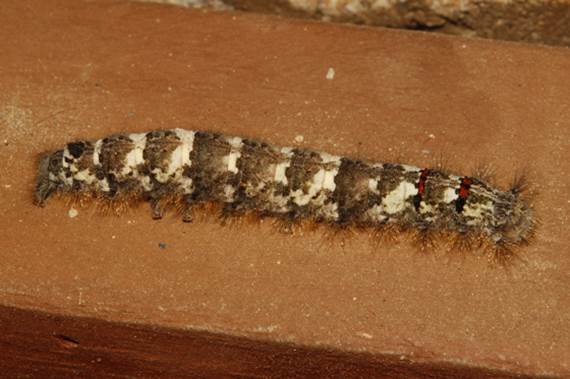
Probably Phyllodesma americana (Lep.: Lasiocampidae) Libby Avis
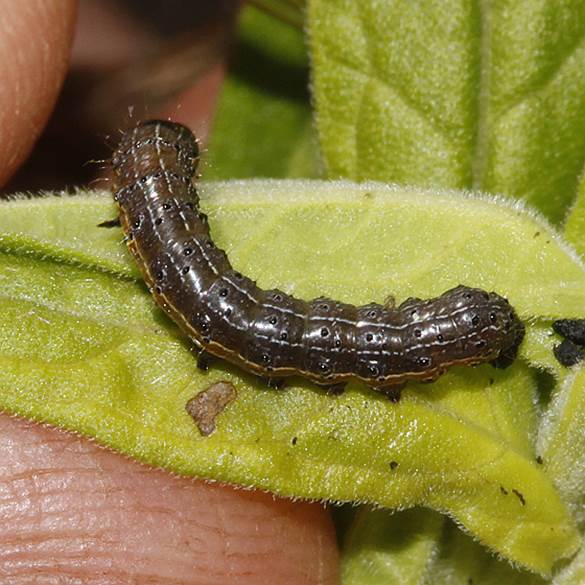
Perhaps Egira crucialis (Lep.: Noctuidae) Libby Avis
Jeremy Tatum shows a photograph of a Neoalcis californiariafrom his Saanich apartment this morning (September 13), and a pupa of Hyles lineata.
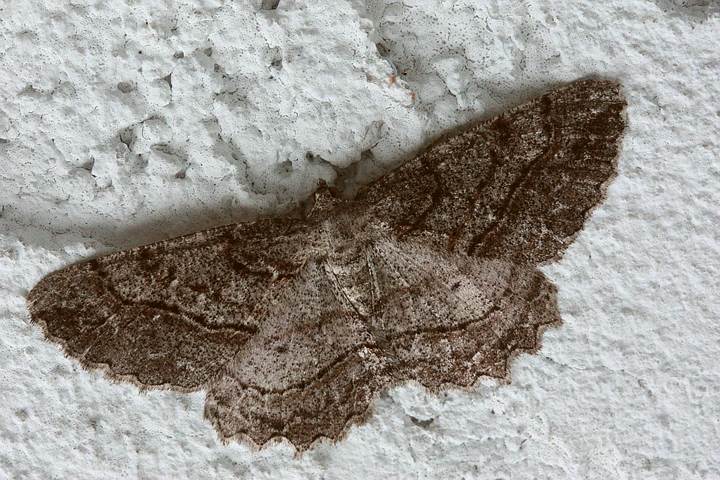
Neoalcis californiaria (Lep.: Geometridae) Jeremy Tatum
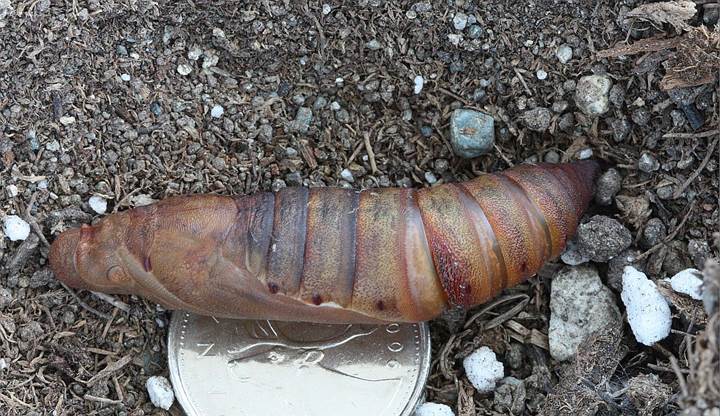
White-lined Hawk Moth Hyles lineata (Lep.: Sphingidae) Jeremy Tatum
2014 September 10
Half-a-dozen VNHS members gathered for a butterfly-watching outing on Sunday September 7. This late in the season, expectations were not high, but it was a beautiful warm, sunny and windless day, so we thought we’d give it a try. We had two target species – the Orange Sulphurs that had been at Martindale Road for several days, and an outside chance of a Purplish Copper at Island View Beach. We got them both, including both sexes of the sexually dimorphic Purplish Coppers. In addition we saw a few of the expected Woodland Skippers and Cabbage Whites. Birdwatching and botanizing were, of course, strictly prohibited, and participants were well-behaved except for one understandable diversion for a brief sneak view of a spectacular plant, albeit a foreign weed, at Martindale, namely an Apple of Peru Nicandra physalodes (Solanaceae). A successful and enjoyable outing!
Also on September 7, Aziza Cooper found several Purplish Coppers on the East Saanich Indian reserve, and she took several photographs to illustrate their variability. The Purplish Copper is the most sexually dimorphic of our local butterflies, and the two sexes look almost like different species. Aziza’s first photograph, below, is a male. He is the one who shows a purplish sheen, but only when viewed at certain angles, and only when he is very fresh. Aziza’s second photo is a fresh female. To add to the complications, her third photo shows a rather worn female whose colours have much faded.
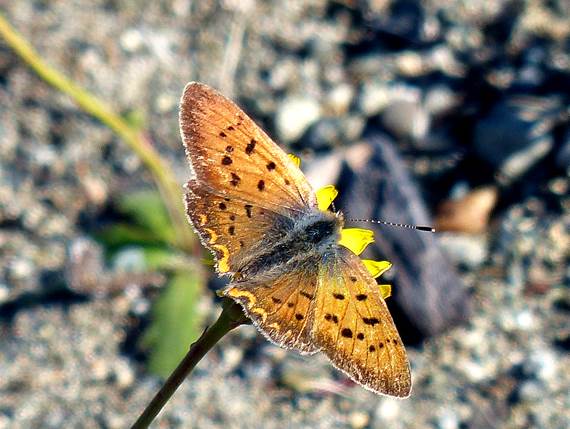
Slightly worn male Purplish Copper Lycaena helloides (Lep.: Lycaenidae)
Aziza Cooper
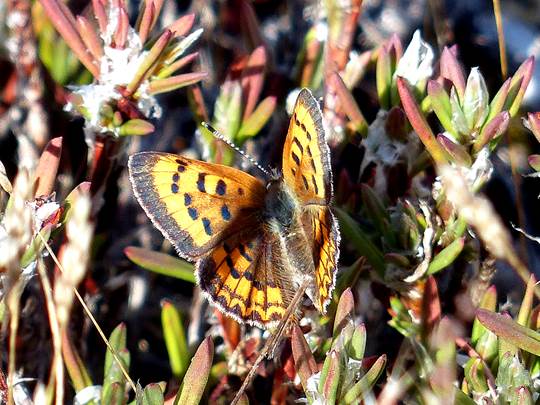
Fresh female Purplish Copper Lycaena helloides (Lep.: Lycaenidae)
Aziza Cooper
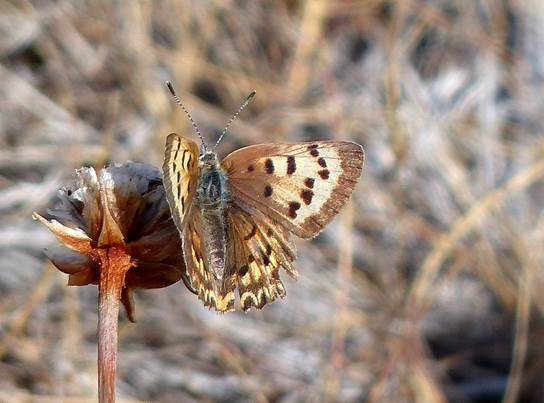
Slightly worn female Purplish Copper Lycaena helloides (Lep.: Lycaenidae)
Aziza Cooper
Jeremy Tatum writes: On August 19 I posted an image of a Hypena caterpillar from nettle at Royal Roads University. The moth emerged on September 7 (photo below) – but I still don’t know what species it is. You can see, however, why these moths are called “snout” moths.
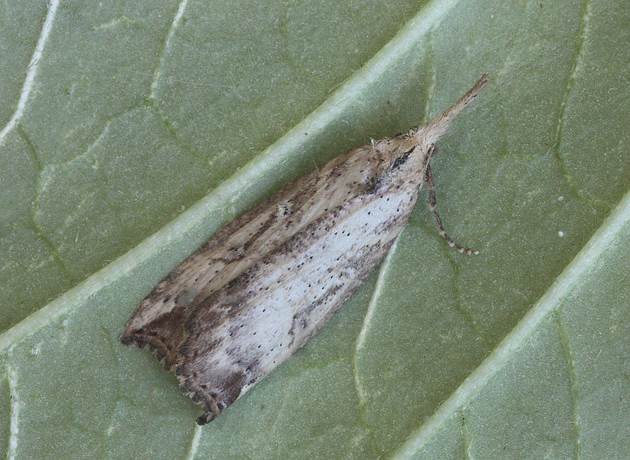
Snout moth Hypena sp. (Lep.: Erebidae – Hypeninae) Jeremy Tatum
Here are two colour varieties of the Yellow Woolly Bear (Virginia Ermine). The yellow one was found by Jeremy Tatum at King’s Pond, and the brown one by Jeff Gaskin and Barb McGrenere at McIntyre reservoir.
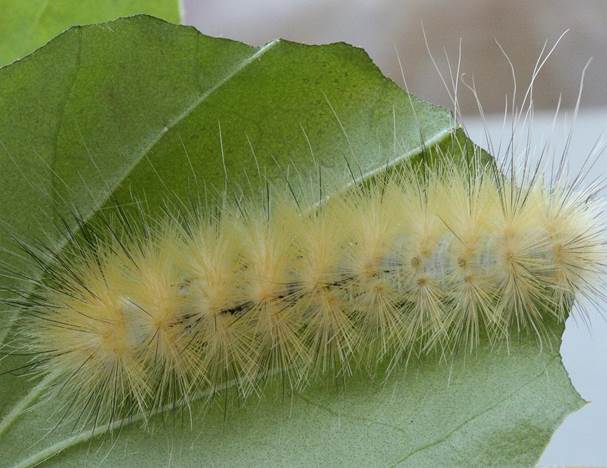
Yellow Woolly Bear Spilosoma virginica (Lep.: Erebidae – Arctiinae)
Jeremy Tatum
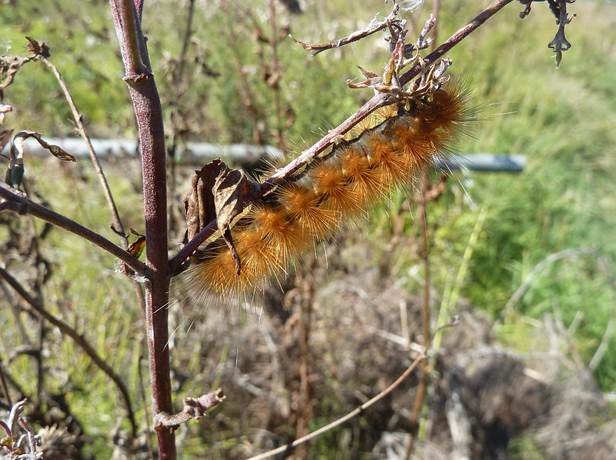
Yellow Woolly Bear Spilosoma virginica (Lep.: Erebidae – Arctiinae)
Barb McGrenere
And here is a caterpillar of Cucullia montanae from Grindelia at Island View Beach.
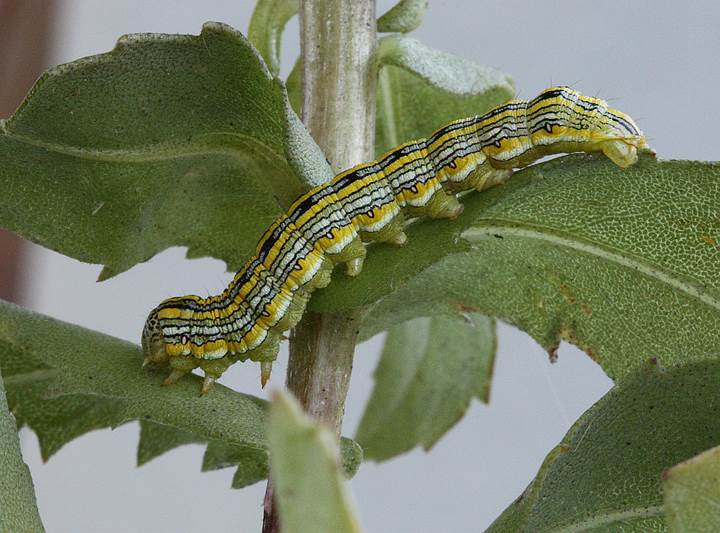
Cucullia montanae (Lep.: Noctuidae) Jeremy Tatum
2014 September 7
Mike and Barb McGrenere report that an Orange Sulphur flew over Tsehum Harbour on September 4. Val George and Jeremy Tatum saw several still at the Martindale location (see August 25 posting) on September 6. Here is Val’s photo of one of the Orange Sulphurs. It may be of interest to compare the markings on the undersides of the hindwings of this and other recent photos (Aziza’s of August 25, and Wendy’s of August 22) with what the books say they ought to be, and to decide whether these markings are useful (or otherwise!) in species identification.
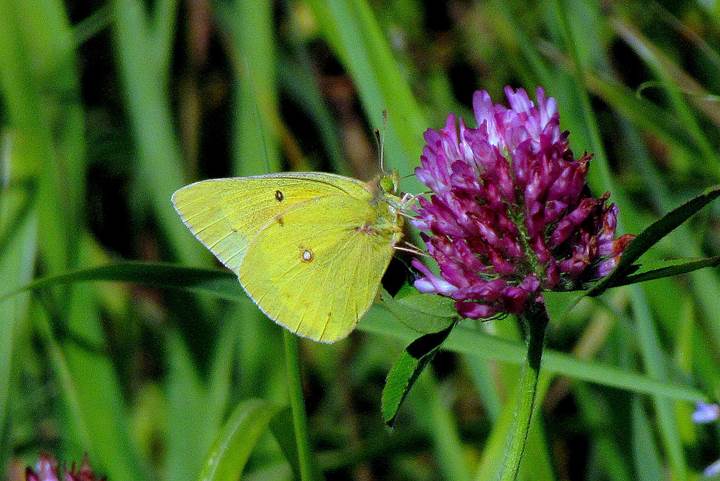
Orange Sulphur Colias eurytheme (Lep.: Pieridae) Val George
Yellow Woolly Bears are much in evidence just now. Val found one on September 6 near the Orange Sulphur location, and Jeremy found one at King’s Pond the previous day.
Leo Dönnecke found a nice moth on Crest Mountain near Campbell River on August 31. It is Bruce’s Tiger Moth – a moth of mountainous alpine meadows in western North America. His dad Daniel managed to get a photograph.
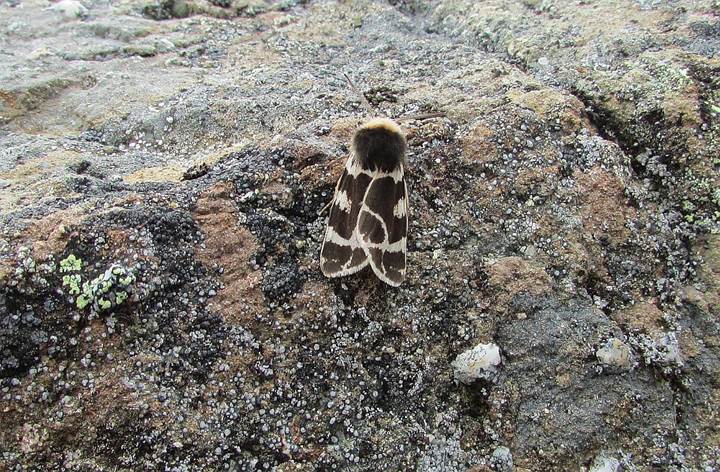
Bruce’s Tiger Moth Neoarctia brucei (Lep.: Erebidae – Arctiinae) Daniel Dönnecke
Although the next photo is a few weeks old, I thought it was worth including, because it shows what is apparently an unusual foodplant for Hyles lineata. The usual foodplant is Epilobium, but this one is on quite unrelated Abronia. It is not a final instar, so it is not a case of a fully-fed caterpillar wandering off its foodplant to find somewhere to pupate, and it looks likely (though we can’t be absolutely certain) that it was using Abronia as a foodplant. The photograph was obtained by Morgan Davies on Sidney Island, where the species is apparently not uncommon, on July 2.
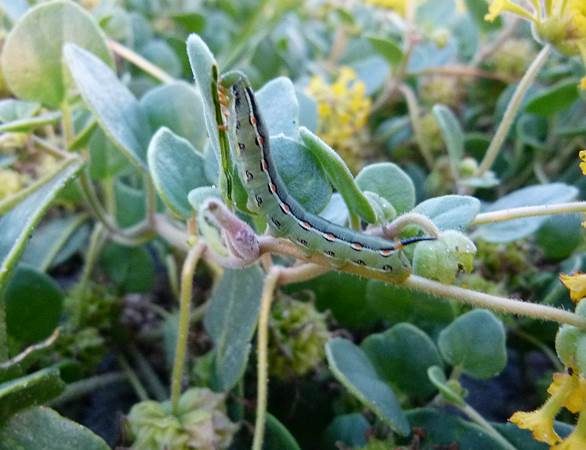
Hyles lineata (Lep.: Sphingidae) Morgan Davies
Bill Katz sends recent photos of two moths from his productive garage on Summit Hill.
I’m putting “probably” before the labels. I am pretty sure that they are correct, but I cannot be 100 percent certain. Opinions welcome!
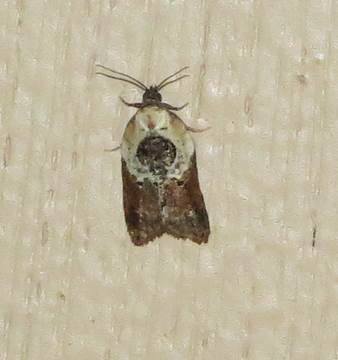
Probably Acleris fragariana (Lep.: Tortricidae)
Bill Katz
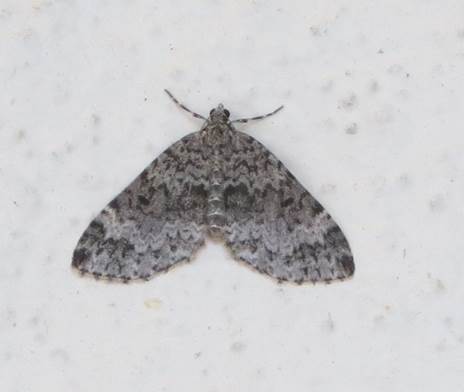
Probably Epirrita autumnata (Lep.: Geometridae) Bill Katz
2014 September 5
In spite of the record-breaking rainfall the other day, there were still a few Orange Sulphurs at Martindale Road on September 4. See August 25 posting for details of the exact location.
Butterflies may be winding down for the season, but there are still lots of other insects around, especially grasshoppers of several species. Here is a photo of a Two-striped Grasshopper, photographed by Aziza Cooper from Uplands Park, August 28, and kindly identified for us by Claudia Copley.
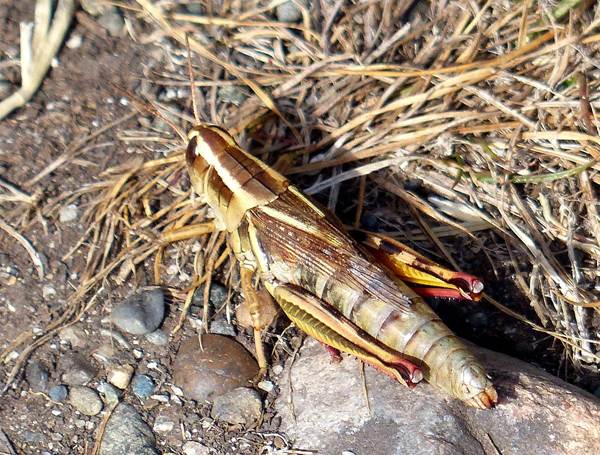
Two-striped Grasshopper Melanoplus bivittatus (Orth.: Acrididae) Aziza Cooper
On September 1 Jeremy Tatum saw a Purplish Copper at McIntyre reservoir. Also at McIntyre reservoir he saw his first Isabella caterpillar (Banded Woolly Bear) of the fall. October is their best month, but this one must have been taking an early stroll.
Yellow Woolly Bears seem to be making themselves conspicuous just now. Here is a photo of one by Val George, Puckle Road, Central Saanich, September 1.
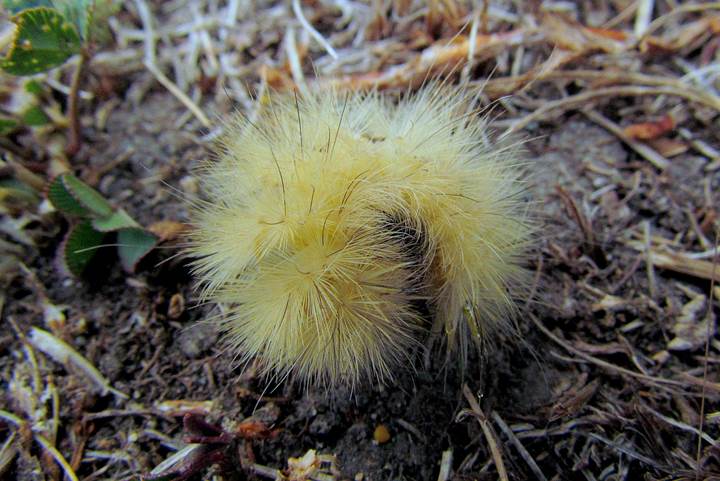
Yellow Woolly Bear (Virginia Ermine) Spilosoma virginica (Lep.: Erebidae – Arctiinae)
Val George
Another woolly bear that is conspicuous at the time of year is the Spotted Tiger Moth. Here is a photo of one taken by Natalie Skinner in Gordon Head.
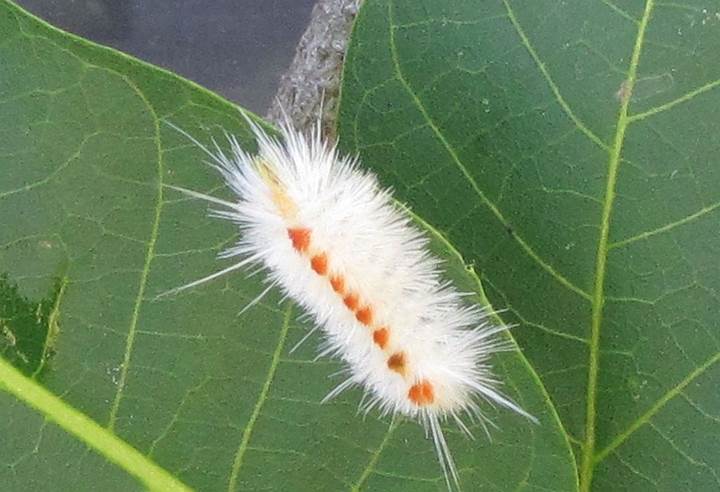
Spotted Tiger Moth Lophocampa maculata (Lep.: Erebidae – Arctiinae) Natalie Skinner
Bill Katz writes: Eva and I were at Goldstream on September 1 and we found an abundance of moths at the Nature House. These are Ipimorpha nanaimo, Lithophane innominata and Lambdina fiscellaria (Hemlock Looper).
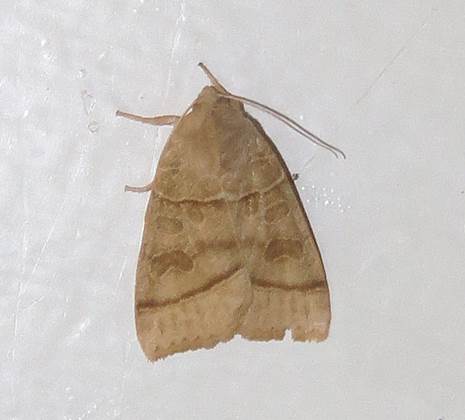
Ipimorpha nanaimo (Lep.: Noctuidae) Bill Katz
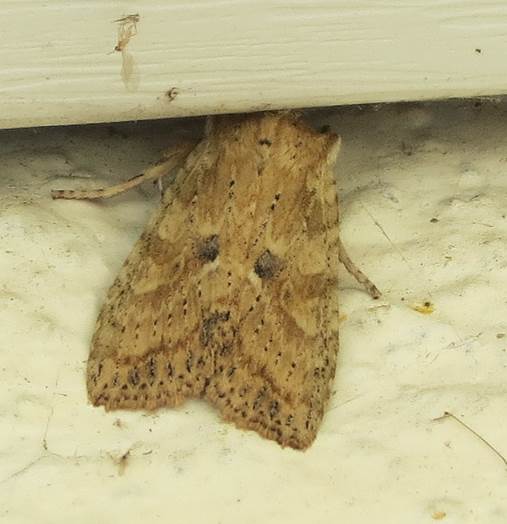
Lithophane innominata (Lep.: Noctuidae) Bill Katz
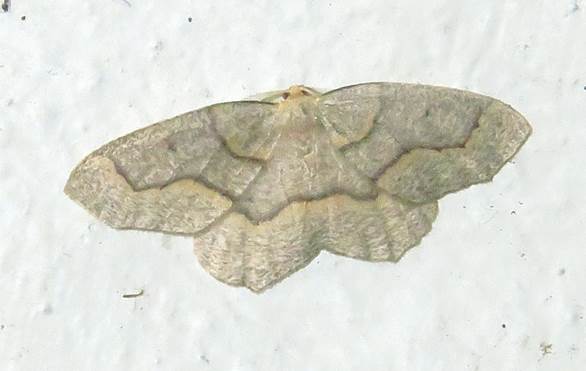
Lambdina fiscellaria (Lep.: Geometridae) Bill Katz
Morgan Davies sends a photograph of a moth seen on Sidney Island Spit on June 16. I’m not 100 percent sure, but I believe it is Euxoa auxiliaris. (Jeremy Tatum)
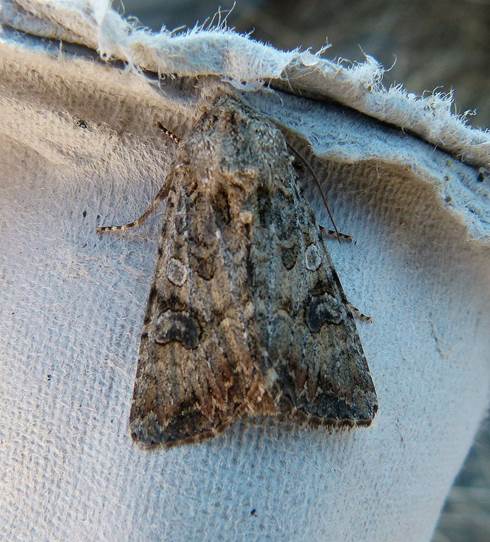
Maybe Euxoa auxiliaris (Lep.: Noctuidae) Morgan Davies
2014 September 1
Gordon Hart sends a picture of the caterpillar of Acronicta dactylina, August 29. This is one of a large genus of moths that look very similar in the adult stage, but the caterpillars are both spectacular and varied. The adult moths carry a dagger-like marking on their forewing, which is obvious in some species, and less obvious in others. The genus on the whole are known as “dagger” moths. Although many of them, like dactylina, are furry, they are not at all related to the “woolly bear” caterpillars.
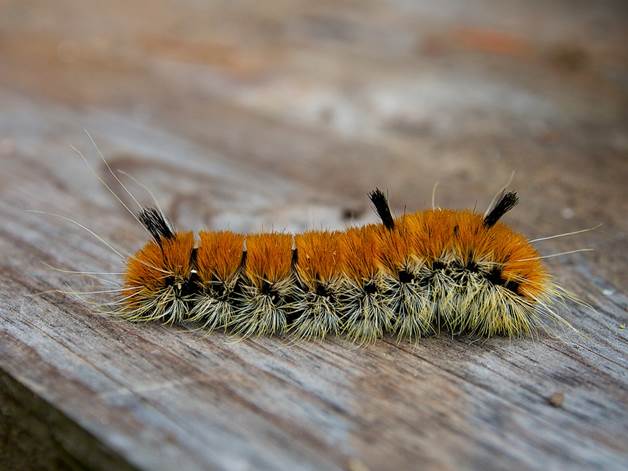
Acronicta dactylina (Lep.: Noctuidae) Gordon Hart
Annie Pang sends recent photos of a variety of insects. If someone can identify the grasshopper, please let us know. The fly might be Lucilia sp. (greenbottle). The stage of development of the maggots of some species enable forensic scientists to determine how long a body has been dead. Some doctors use the maggots for treating infected tissue in injured patients. Apparently it is often quite successful. Some species lay their eggs in the nostrils of frogs and toads – but I don’t think anyone will want to know what happens next. The Leafcutter Bee can be recognized in that it gathers pollen on the underside of its abdomen rather than on its legs like a Honey Bee.
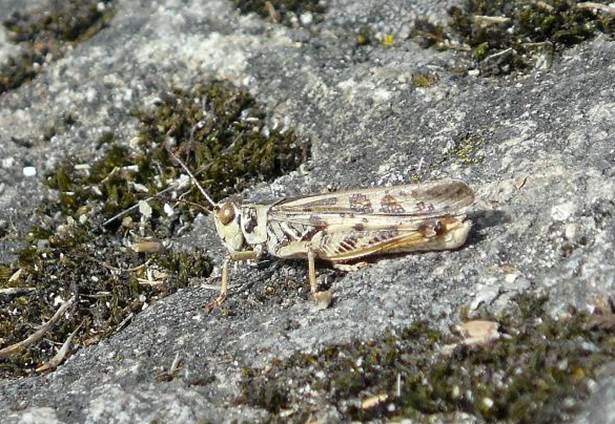
Grasshopper (Orth.: Acrididae) Annie Pang
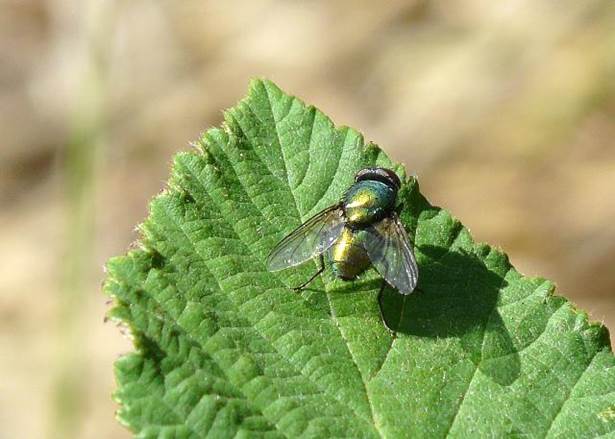
Blow Fly, possibly Lucilia sp. (Dip.: Calliphoridae) Annie Pang
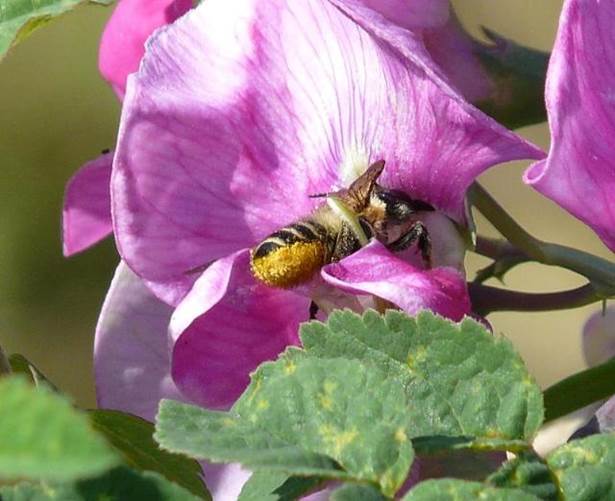
Leafcutter Bee Megachile sp. (Hym.: Megachilidae) Annie Pang
Bill Katz sends a photo of a caddisfly from Goldstream Park, and the moth Xanthorhoe defensaria from the Interfaith Chapel at Finnerty Gardens.
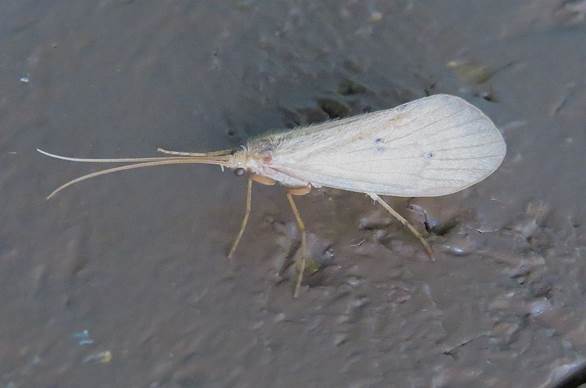
Caddisfly (Trichoptera) Bill Katz
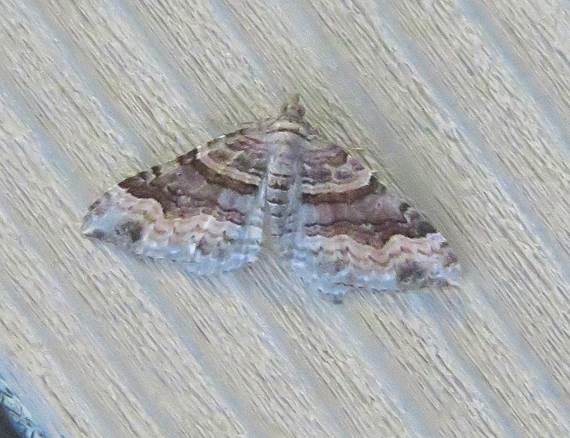
Xanthorhoe defensaria (Lep.: Geometridae) Bill Katz
Mike McGrenere writes: I was cycling in the Martindale/Island View area today (Aug 29) and was able to see two Sulphur butterflies. The first was along Welch Road north of Martindale Road where there is a corn field. Gerry Ansell had two there a while ago and there was still one there today along with Cabbage Whites. The butterflies like the flowering plants along the edge of the corn field.
The second one was in a new location. It was along the west side of McIntyre Reservoir. The butterfly flew out of the weedy onion field as I was walking along the farm road and it disappeared into the dry grass/weeds on the edge of the reservoir. I am assuming that this was an Orange Sulphur like the others in this general area but I did not get any field marks except for the yellow colour and erratic flight. The number of Cabbage Whites was down considerably from last week with only two along the reservoir. I saw two other butterflies which I think were a Purplish Copper and a Mylitta Crescent.
Jeremy Tatum writes that on August 30 between Island View Beach and Cordova Spit he saw several Purplish Coppers, Large Heaths (regular viewers of this site will know that I am referring to the so-called “ringlet”) and Woodland Skippers. The Purplish Coppers, male and female, were looking pristine fresh, while the Large Heaths were, shall we say, somewhat past the first fresh flush of youth.
Here are two colour varieties of the Spotted Tiger Moth caterpillar (Ken Strothcamp would welcome all photos of this species), and what I think is the final instar of the White-lined Hawk Moth caterpillar, earlier instars of which we have seen on August 25 and 29. It truly is a most spectacular animal. It is about the size of my middle finger.
